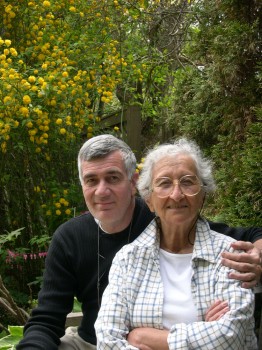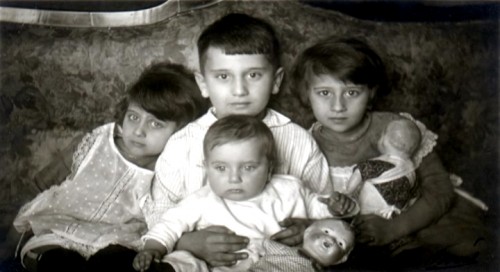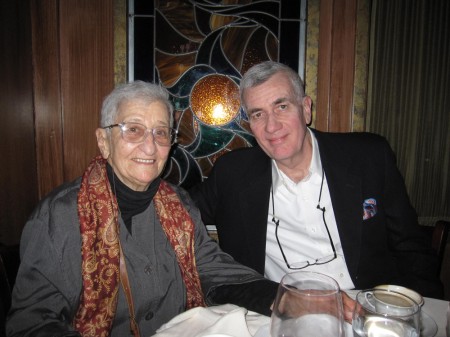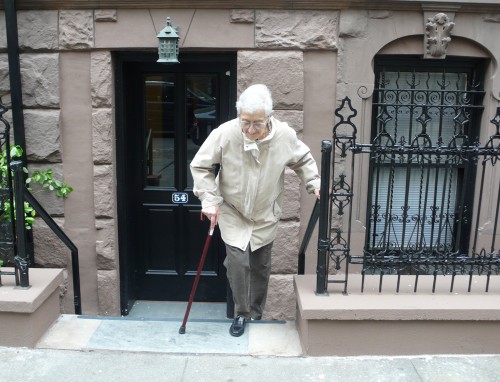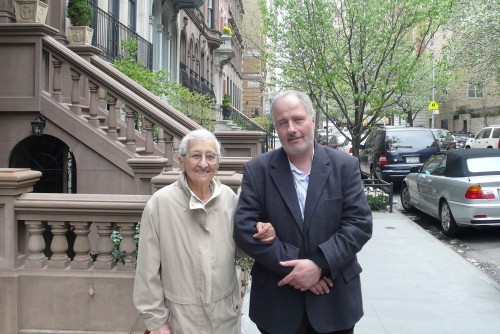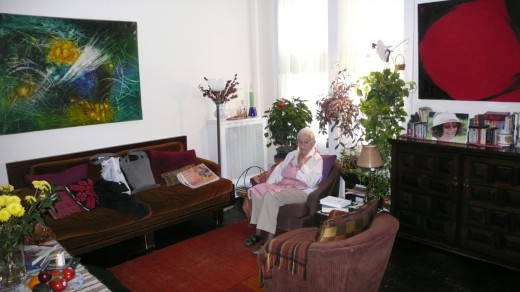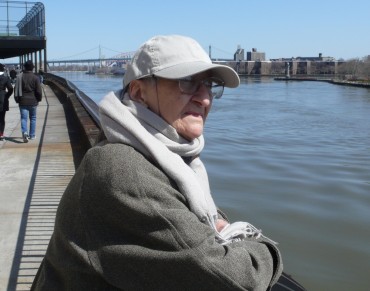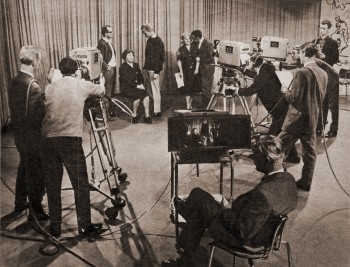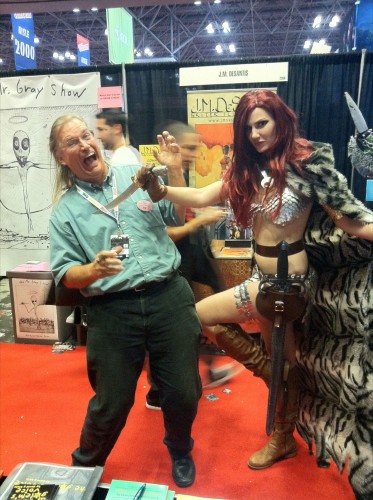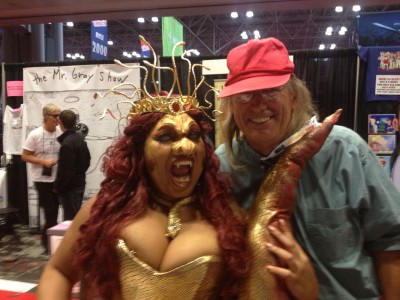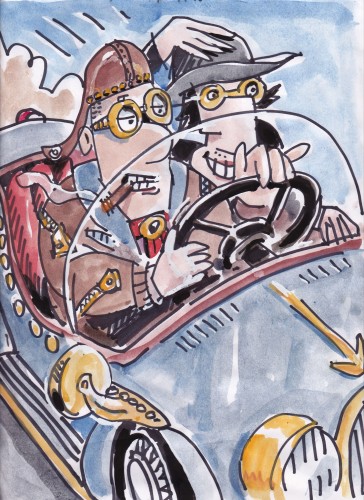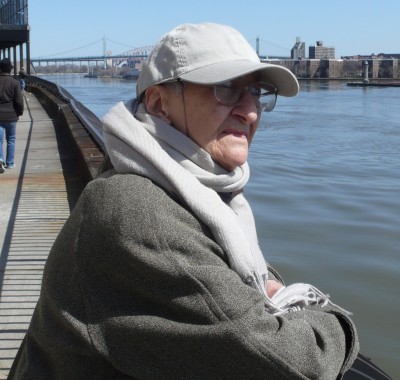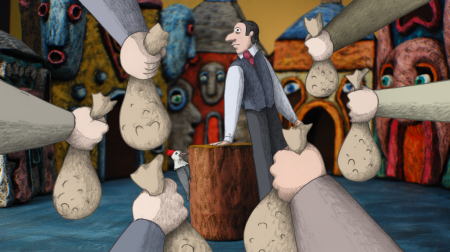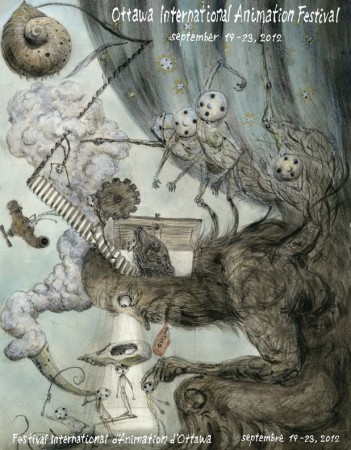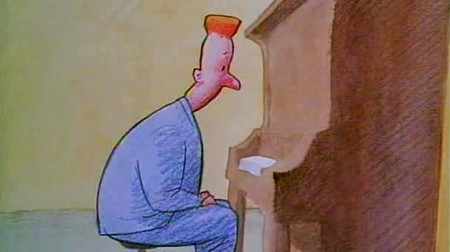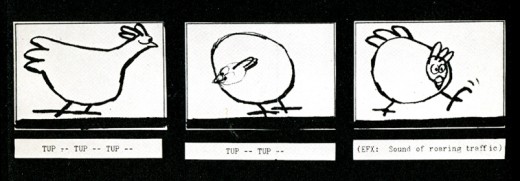Search ResultsFor "cockaboody"
Daily post 09 Nov 2013 09:26 pm
Your Alice
Just who was ALice?
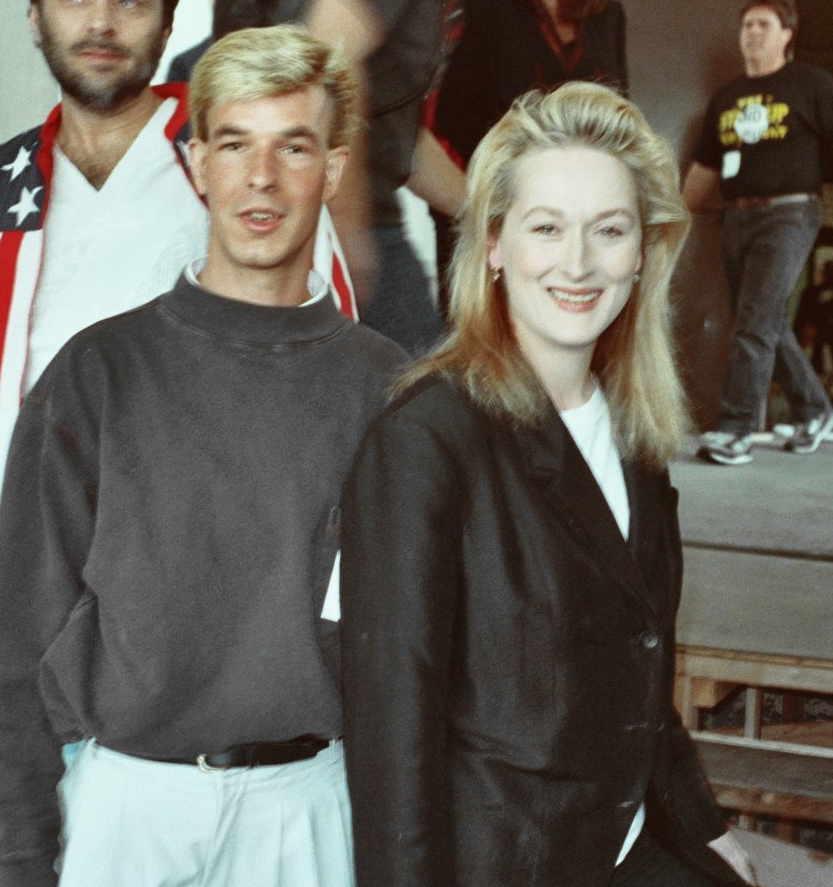 This little girl who walked about with the intelligentsia of mid nineteenth Century Oxford. And she affected them all somehow. Charles Dodgson in a skiff took her boating on the Thames, posing as the writer Lewis Carroll, and told her stories of herself and the world that really didn’t exist in her mind but rather in Carroll’s. It took a hundred years for one of the greatest playwrights of our time, Dennis Potter, to make a movie of her older self looking back on the past years of a “Dream Child.” She inspired artists like all of the greatest with Raiph Steadman filling up volumes and volumes of illustrations with pictures of a good little girl acting bad. That slight resemblance to Meryl Streep who played Alice for Eve La Gallienne. It’s all too in-bred, artistically. Ask Robert Wilson who could barely get his character of Alice to pose for his photographs. Tom Waites wrote songs and a German theater troupe sung them.
This little girl who walked about with the intelligentsia of mid nineteenth Century Oxford. And she affected them all somehow. Charles Dodgson in a skiff took her boating on the Thames, posing as the writer Lewis Carroll, and told her stories of herself and the world that really didn’t exist in her mind but rather in Carroll’s. It took a hundred years for one of the greatest playwrights of our time, Dennis Potter, to make a movie of her older self looking back on the past years of a “Dream Child.” She inspired artists like all of the greatest with Raiph Steadman filling up volumes and volumes of illustrations with pictures of a good little girl acting bad. That slight resemblance to Meryl Streep who played Alice for Eve La Gallienne. It’s all too in-bred, artistically. Ask Robert Wilson who could barely get his character of Alice to pose for his photographs. Tom Waites wrote songs and a German theater troupe sung them.
The girl owes us nothing. She played the part for a small time minister and has happily lived through history of Art. She was not even a model for Picasso or Braque or Cezanne. Yet she changed history.
Tomorrow more of Ralph Steadman’s brilliance. That’s what I’ll post.
She was just a small child playing Cockaboody.
Daily post 19 Oct 2013 03:44 am
Hubley & Julian samples
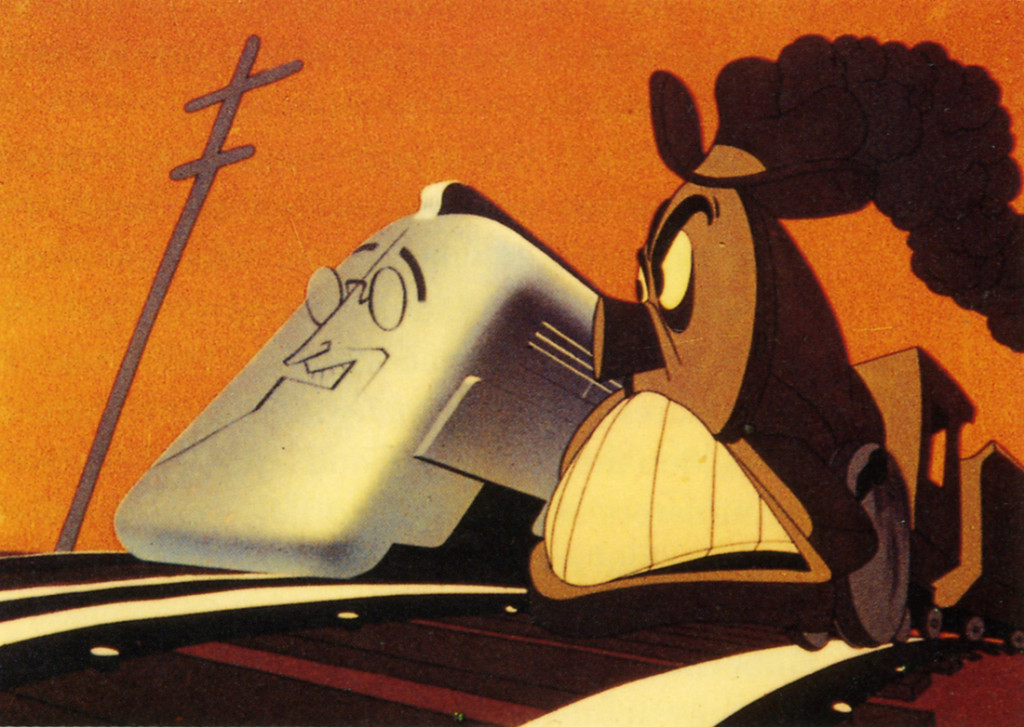 In his book, When Magoo Flew, The Rise and Fall of an Animation Studio – UPA,writer, Adam Abraham details the story of a group of artists working together a new series of films. John Hubley wasn’t always happy though he was undoubtedly one of the leaders of the artists who came together from different sources. Many from Disney, some from the US Army Signal Corps, others from Chouinard Art Institute -a school supported by Walt Disney in his attempts to gain artists for the films he made in LA.
In his book, When Magoo Flew, The Rise and Fall of an Animation Studio – UPA,writer, Adam Abraham details the story of a group of artists working together a new series of films. John Hubley wasn’t always happy though he was undoubtedly one of the leaders of the artists who came together from different sources. Many from Disney, some from the US Army Signal Corps, others from Chouinard Art Institute -a school supported by Walt Disney in his attempts to gain artists for the films he made in LA.
The stories behind the films were done wholly to advance the new art forms being discovered in Los Angeles. It was their notion that by breaking the rules of 19th Century Art animation could begin to come truly alive as an original.
Two of the artists were truly original in the approach, and when they started working together a curtain unveiled something new.
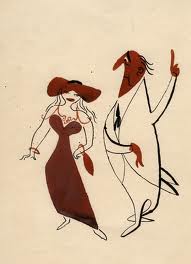 John Hubley was one of the bosses and one of of those who brought strength to the films he created. In the beginning he worked with the animator, However, he was bothereed by some of the color choices made others, particularly by BG artist artist Herb Klynn. Hubley was incensed at the ugly yellow/green that Mr. Klynn would incessantly choose. For this reason (among others) he brought in the gifted master painter Paul Julian to do the the background coloring. Hubley, himself, was a strong designer and a master painter. Who could question what he wanted to do with the department.
John Hubley was one of the bosses and one of of those who brought strength to the films he created. In the beginning he worked with the animator, However, he was bothereed by some of the color choices made others, particularly by BG artist artist Herb Klynn. Hubley was incensed at the ugly yellow/green that Mr. Klynn would incessantly choose. For this reason (among others) he brought in the gifted master painter Paul Julian to do the the background coloring. Hubley, himself, was a strong designer and a master painter. Who could question what he wanted to do with the department.
Once past a couple of near-sighted Fox and Crow films; Hubley wanted to do films about humans, not animals, and he eventually got his series featuring the near-sighted Mr. MaGoo. In the big picture, though, they were forced to follow many artistic constraints. Despite this, they two did a number of very successful shorts in changing the look and feel of animation globally.
The films done by both Hubley and Julia
Continue Reading »
Commentary &Tissa David 05 Nov 2012 07:27 am
Speeches
At the memorial service for Tissa David five people gave speeches. I have some of those talks and am posting them here. I also have some photos that I’ll post with them. The photos are identified at the end of the post.
The entire evening was hosted, essentially, by Tissa David, herself. A 90 minute video shot at NYU has Tissa talking about her career and animation, in general. I’ve chosen a lot of clips from this video. Our entire program starts with Tissa talking to the audience about her love for animation. Short clips then precede every section of later film clips screened, and the very last word of the evening is also Tissa’s.
John Canemaker was the first speaker:
- Sunday in the Park with Tissa.
I walk across Central Park at noon to Tissa’s residence on East 83rd Street, a cozy one-bedroom apartment that always smells of baked apples and spices. It’s where she has lived since coming to New York from Paris in 1956; and that’s the year she began working as assistant to master animator Grim Natwick at UPA Studios, then located on Fifth Avenue.
It is a perfect autumn day: crisp and cool, trees in full-color spectrum, bright sunlight. The New York City marathon is in full swing. Barricades, crowds cheering the runners, detours to get you where you need to go. Friendly, happy people everywhere. New York City at its gridlocked best!
Tissa is waiting patiently outside her building, age 90 and ready to go. She wears a white peaked cap, purple/pink sweater and a stylishly long, beige raincoat over wool slacks and shiny black shoes. And she holds a rubber-tipped black cane.
She attended Catholic mass this morning, as she does every day at St. Ignasius Loyola, a church around the corner on Park Avenue run by Jesuits. As is our custom, I lean down to air-kiss one cheek, then the other, saying, “in the European manner.” She smiles and mimics me: “Yes. In the European manner.”
She takes my arm as we walk very slowly toward the Metropolitan Museum of Art two blocks west of her apartment.
She expresses interest in seeing the new Met galleries for “Art of the Arab Lands.†Both sides of her family are Armenian and the rugs of the Arabs stir her, she says.
“Have ever been to Spain?†she suddenly asks.
“Barcelona,†I answer.
“Barcelona is not Spain,†she responds. “It is — Barcelona. I mean a city like Granada, such a beautiful city. The Moorish influence in the city’s architecture and art.â€
Tissa has strong opinions about everything, especially art. I remember some years earlier running through a gallery at the Met containing one of Damien Hirst’s dead animals in formaldehyde, trying to keep up with Tissa as she hissed like a cobra: “Diss-gusting! Disssssss-gusting!â€
Her tastes are eclectic, but she maintains a special passion for Giorgio Morandi, who once said, “Nothing is more abstract than reality.†There is something in Morandi’s quiet, reclusive, deeply thoughtful, and pared-down paintings that speak to her on both personal and professional levels.
Today, however, instead of entering the museum she prefers that we walk; or, as she pronounces it in her soft Hungarian accent, “ve vauk.†Passing windows containing the Temple of Dendur, we pause. The slightly uphill route winds Tissa and she points her cane toward a cement wall. We sit watching marathon runners dash past, cheers erupting from the young crowd around us who greet the exhausted competitors, who have run for hours through all the boroughs and down Fifth Avenue and into the park for a finish near Columbus Circle.
A runner in a Superman costume hobbles by. Tissa is enjoying everything about the moment and the day, and so am I.
We talk of mutual friends. She remarks how happy she is that Michael Sporn is working on a new film. She says how much she loves Emily Hubley’s feature, The Toe Tactic.
Emily’s father, the legendary animation designer/director John Hubley, defied sexist barriers against women animators in the 1950s and 60s by hiring Tissa to animate several prestigious commercials and shorts. Tissa loved working for him, even if, she candidly notes, he was “cheap†when it came to salaries.
After ten minutes or so, we continue down the path and sit on a bench in the sun near Greywacke Arch, as runners gallop and limp across the bridge.
Inevitably, Tissa speaks of her longtime mentor Grim Natwick. And soon comes the mantra that is well-known to all her friends: “I really learned everything I know about animation from Grim.â€
She learned her lessons well. After Natwick retired, she slowly became recognized as one of the world’s great animators, and a pioneer who forged a brilliant career in a male-dominated industry. Charm, vivacity, female sensuality radiates from her superbly staging and well-timed animation, which is weaved into an admirable economical style. “You don’t do many drawings, “ she often advised novices, “but you know how to use them.â€
She thinks about animation constantly. She wonders how she would animate the Met’s splashing fountains. She ponders the numbers on digital clocks, which change shape instantaneously.
“I stare at the numbers,†she says, “and think about how I would animate the change from one to the other.â€
“It isn’t fully metamorphic,†I suggest, “but a decision about where the animator would ease into the new change.â€
Tissa thinks about that. “I would make the inbetween drawing closer to the ‘old’ number before the change,†she decides, “so there is a snap into the new number.â€
I ask Tissa if she ever wanted to marry or was in love. “Oh yes,†she answers. “I was in love many times and wanted to marry a doctor. But I was glad that he was shot by the Russians.â€
Seeing my shocked expression, she quickly adds, “I mean that it was better that I never married him because I would have quickly been miserable and it would have never worked out.â€
What about Grim?
Laughing, she says she loved him and he loved her, but it was never a romantic love. “He was my teacher. He was like my father.
“The greatest love of my life,†Tissa admits, “ was the art of animation.â€
She reflects that parts of her life have been hard. I assume she’s referring to the 1944 siege of Budapest, and her daring escape from Communist Hungary, or difficulties through the years finding her way as a female artist.
But she is thinking of more recent and personal troubles. “Between 2000 and 2010,†she explains, “I lost two brothers, two sisters, nephews and a niece. The loss of so many loved ones was almost overwhelming. I’m still angry with my younger sister Margit for dying and leaving me. She killed herself with smoking,†Tissa explains with bitter sadness.
We make our way up Fifth Avenue, then turn eastward toward her apartment.
“Thank you, John. It was really great to get out and valk.â€
I thank her for the opportunity to escape my cloistered work habits.
“You’re a long distance runner,†I say, “like the marathon racers.†She smiles and reminds me that I wrote that line in 1977 as the heading of her chapter in my first book The Animated Raggedy Ann & Andy. I don’t remind her that the full title was “Tissa David: The Loneliness of the Long-Distance Animator.â€
At her apartment house, we air-kiss “in the European manner.†My offer to help her down two steps to the front door is refused.
“I can do it,†she insists.
And she did.
This talk was followed by clips from the Hubley films:
Cockaboody
Eggs
Everybody Rides the Carousel (the Meryl Streep sequence)
Howard Beckerman followed John Canemaker
- Tissa David
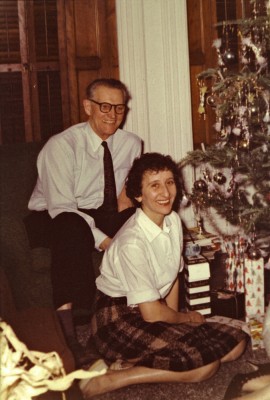 Tissa, after working at Paris based studios, entered New York animation in 1955 at UPA situated diagonally across from the Museum of Modern Art and John and Faith Hubley’s Storyboard, Inc. It was the right place for her.
Tissa, after working at Paris based studios, entered New York animation in 1955 at UPA situated diagonally across from the Museum of Modern Art and John and Faith Hubley’s Storyboard, Inc. It was the right place for her.
There had been few women animators in New York in past decades but, among the men, the held opinion was that women couldn’t do the job. There was also a general attitude that the craft was dominated by Americans. To them animation was a trade for which females and foreigners need not apply. UPA, however, was a progressive studio where the staff included various minorities and nationalities. As one talented African-American artist remarked, “When you walk in here you feel comfortable and welcomed.”
Tissa was greeted by animator Grim Natwick. His European art studies long behind him, he was the choice crew member to interview the then English challenged Tissa. Natwick was direct, ___________Tissa and Grim at Christmas
“What do you think of animation?”
Tissa hesitated , then replied, “Animation is animation.” That satisfied Natwick. Tissa was given a try out on a character from the studio’s popular Piel’s Beer commercials and then hired. The brief meeting with Grim was expressly important because the film that inspired her to get into animation was Disney’s Snow White and the Seven Dwarfs for which Natwick had animated 80% of the lead character. Tissa became Grim’s assistant beginning an association that lasted 35 years.
In time, Tissa became an animator in her own right at local studios giving life to TV commercials. Later came requests from producers with a broader range of diverse characters. These included John and Faith Hubley, R.O. Blechman and Michael Sporn all who came to depend on her animation skills and unique intellectual qualities. Tissa entered a legacy laid down by earlier European animators, illustrators and designers whose influence profoundly effected American cartoons. Working at Disney and Fleischer Studios, their affinity to old world castles, cottages and colorful personalities added credibility, charm and warmth to animated features.
Tissa also played an outstanding role in the ASIFA-East chapter. She organized and corralled the membership lists and dues collections. This was at a time when new graphics guilds were entering the field with lists of 2000 or more, but Tissa proudly managed our 250 or so enthusiatic members.
She was a prime promoter and facilitator of the ASIFA-East Film Festival, and tabulated the voting results as well as commanding the arranging of the event’s refreshment tables. Under her discriminating gaze many of us schlepped wine bottles and tubs of cheese.
I worked with Tissa at various studios around the city and remember a gratifying moment one rainy day when she and Grim came to one of my classes. They had gotten lost in SVA’s internal maze, arriving late and dripping wet. Though tardy, they added substance to the class by answering questions and giving weight to the realities of the field. To the familiar student concern about whether the character of Snow White was traced over live-action actors, Grim, chalk in hand, sketched Snow White to clearly illustrate why her cartooned proportions didn’t allow for rotoscoping.
There’s one anecdote regarding Tissa that I’ve repeated many times, but it still warms my heart, so pardon me if you’ve heard this before. I feel it’s worth repeating since it indicates Tissa’s warmth, humor and life-energizing spirit that rose above everyday twists and turns.
Tissa often traveled to Europe to see family and to animate for small studios. She also had a country house in Southern France. In the spring of 1974, while working in Holland, she contacted Iris and I about attending the animation festival in Zagreb. Her suggestion was that we meet her in Paris a week before the event. She kept a small Volks station wagon there and proposed that we drive across Europe to Zagreb. We accepted gladly. It would be a wonderful journey with a great guide. After a night in Paris we drove south through agrarian countryside evoking the colors of Van Gogh and other post impressionist painters. We stopped in a small town so Tissa could check out her French country place and then we found a small, inexpensive hotel for the night. Tissa suggested that Iris and I take a back room and she a front room. Our lodging was simple, but when we opened the shutters to let in the good night air, we saw the shining moon behind silhouetted castle towers. We slept soundly.
The next morning at breakfast we wondered if she had slept well. “Oh it was terrible!” she replied, “Big trucks rattling past my window all night!” We traveled on through southern France and into northern Italy. One late afternoon we arrived at a local hotel and prepared for a night’s rest before entering Venice. We agreed that this time Tissa would take a back room and we a front room. We slept soundly.
In the morning came our question,” How did you sleep?” It was terrible!” she replied, “There were people playing guitars and singing all night in the courtyard!”
Tissa David will be remembered as a person of taste, humor, artistic skills and a wide understanding of people and the world in general. She observed and interpreted things in a private way. She appreciated much but was opinionated and disdainful of things that didn’t meet her standards. Tissa was a dedicated animator on all manner of productions from workaday TV announcements to celebrated award winners. Though a very private person, she was a friend and mentor to many. She was a treasure in our midst. For all of us who knew and admired her, she will be missed.
Howard’s talk was followed by a clip from Raggedy Ann and Andy
her Candy Hearts and Paper Flowers sequence.
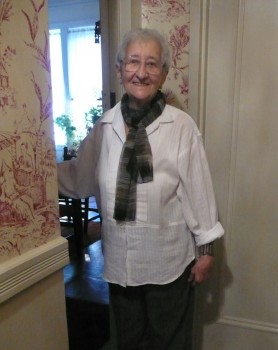 R.O. Blechman was the next speaker. His short talk was planned but spoken off the cuff, improvised. There’s no transcript of it.
R.O. Blechman was the next speaker. His short talk was planned but spoken off the cuff, improvised. There’s no transcript of it.
He started by quoting a poem Tissa liked by T.S.Elliott in which Tissa had substituted the word “animator” for “poet”. Bob also told the story of an article about his show Simple Gifts in which he called the 5 designers, “Artists.” Bob was surprised that Tissa had confronted him by telling him that she was an “Artist” yet there was no mention of her in the promotional article.
Bob’s talk was followed by clips from his studio:
3 commercials for:
– Perrier
– Banco
– WQXR radio
a clip from a promotional trailer for Candide, a film Bob sought to make as a feature.
a clip from The Soldier’s Tale, Blechman’s Emmy winning adaptation of Stravinsky’s work.
Candy Kugel was the next speaker.
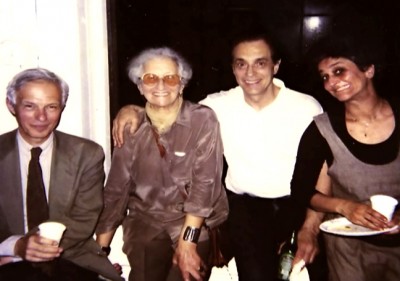 Tissa was my role model—a pathfinder. When I entered the animation industry in the 1970’s there were no other female animators beside her and I was experiencing the same sexist attitudes as she did. And I was in awe of her ability—her fluid line and acting. And finally, I was always grateful for her introduction__________(LtoR) Blechman, Tissa, Vince Cafarelli, Candy Kugel
Tissa was my role model—a pathfinder. When I entered the animation industry in the 1970’s there were no other female animators beside her and I was experiencing the same sexist attitudes as she did. And I was in awe of her ability—her fluid line and acting. And finally, I was always grateful for her introduction__________(LtoR) Blechman, Tissa, Vince Cafarelli, Candy Kugelto international animation and ASIFA.
The first time I was introduced to Tissa was on the telephone in the summer of 1972. I was about to go to Italy for my last year of art school after spending summers interning at Perpetual Motion Pictures.
My boss, the designer Hal Silvermintz, told me that Tissa knew everyone in Europe and she could give me the names of studios so that I could visit them while there. She did, and I did – in Rome, Zagreb and Budapest. And then, since Annecy would have its festival that June, she encouraged me to go and gave me the address to write for certification.
I did go to Annecy and it opened my eyes to international animation in a way I could never have imagined before. There was no internet then, no DVDs and no video collections—the only way you could see these movies was projected in a theater. And I do remember briefly meeting Grim Natwick (who drew me a Betty Boop) and Tissa.
When I returned to New York, it was a bad time for animation so I went to Los Angeles to try my luck there. In New York I had had the good fortune to be treated well by my bosses—my main responsibility was to help the designer.
I had some rudimentary animation experience, but the real animation was done by experienced animators, and they came from a culture of secrecy.
In LA I went to Disney with my “reel†and portfolio and found a whole other set of obstacles. The front gate passes had “Mr.†printed on the guest line. This was during the feminist movement and I jokingly said to the woman behind the window—“I guess you don’t see very many women hereâ€â€”she scratched off the Mr and roughly handed it back to me. I met with 3 men, including Don Duckwall. They told me I drew nicely but that women just don’t have what it takes to be an animator. Women lack timing. Maybe I should consider becoming a designer or background artist.
“But I want my drawings to ACT!†I protested. They smiled and shook their heads.
In the end, I returned to work fulltime at Perpetual. I was determined to learn how to animate well. I got to know Tissa through ASIFA and she offered to help me.
Perpetual picked up a project that had an incredibly low budget, so they gave it to me. Whatever I could manage would be enough. Vincent Cafarelli had recently started freelancing there, and although he was open to helping me, he encouraged me to seek out Tissa’s advice. They had worked together at UPA and he had great respect for her. He even told me I flipped like her.
Tissa invited me to her home and she demonstrated some things. And gave me homework. I went a few more times—I wish I could say that I was a stellar student, but I’m afraid her criticism, although completely deserved, was too biting for my fragile ego.
She was my idol—I loved her work – her beautiful line and her acting. I respected her immensely—but I think I must have been a great disappointment to her. At that time, I was the only girl working her way to become an animator in an established animation studio in NY. I imagine she was hoping for a protégé equal to her talents.
But even without the lessons we remained friends. She followed my career closely and we worked together in ASIFA.
We both understood the difficulty in working in a “man’s profession.†I was criticized by the ink and paint department for not being one of the girls—I was a guy because I used a pencil and not a brush. Outside of Perpetual there were animators and assistants who thought it wrong of me to take a man’s job. Some kiddingly said they would “break my fingers.â€
I admired Tissa even more, knowing exactly what she had been through.
But we never spoke about it after our first meeting at her apartment: I gingerly asked her about how she dealt with the male animators—their practical jokes, the macho culture–were there rumors about her and Grim? She looked at me harshly and waved her hand. Who needed to complain—it was just part of the job.
I will miss Tissa—her generous spirit, her biting wit and her talent. There are too few of them out there.
Candy’s talk was followed by clips from 3 films done for Michael Sporn Animation:
Lyle Lyle Crocodile
The Red Shoes
The Story of the Dancing Frog
Arlane Nelson was the next speaker.
- As Michael said, I am one of Tissa’s nieces. An interesting side note, Tissa was one of 10 children, 7 girls, 3 boys. In my generation, the next one, there were only a total of 3 girls among all the nieces and nephews.
I’d like to begin with an email one of my Hungarian cousins sent me:
“Tissa was known to love music, and we had talked a lot about our favorite performers: Horowitz, Goild, and many other artists. However one thing that is not common in elderly people, is to be open to new things, as Tissa had been. Once I saw a movie about the life of Manuel de Falla, which has a lot of music inserted, one even recorded during his short life. The recording is very interesting because when Falla wrote his masterpiece, El Amor Brujo, he wanted to reject it because the passion radiating from the piece is in total contrast with his deep catholic faith.
Manuel de Falla, just as Kodaly did, collected folk music, the music of the flamenco playing gypsies. El Amor Brujo totally gives back this surreal feeling. In the movie, in order for the illustration to be perfect, two songs, that are accompanied by a large orchestra, were sung by a young female gypsy singer with the technique typical to flamenco. The passion radiating from the recording is scary. I showed it to Tissa who said that this woman is like a storm. And she started telling me stories about being in Andalusia, listening to flamenco music, and how much she liked it.
The other memory is connected to flamenco as well. Many people think that they like this musical style, while they only meet the civilised versions. I have watched Saura’s movie, called Flamenco in which there is a part when two old gypsy men sit on a chair and sing without music. One of them has golden teeth, the other one has silver teeth. This is of course not singing according to European standards, this is rather some endless, sharp, painful, and aggressive shouting, confined among borders. As far as my experience goes, only a few can understand this deepness of art. Tissa understood it, we talked a lot about it later on, and she pointed out the complicated symbols in the text that I had missed on my own.â€
Anyway, I live in the Washington metropolitan area and as such, we used to see Tissa a lot; more than any of our other relatives. She’d be down to visit us several times a year and sometimes, we came up to visit her. I’d like to share a few of my memories of who Tissa was.
Growing up, we kind of knew that Tissa was a famous person and we were very proud of this. I can remember, when my sister and I were small and Tissa came to visit, we had to wait until the morning, but we would go charging in and have her tell us the latest Letterman shorts she had done. So we’d know the stories before anyone else did.
 Tissa loved cooking. Whenever she came to visit, she took over the kitchen; you entered at your own risk. Except for the dogs, who usually waited in endless vigil watching every step, every action with rapt attention for the treasures they knew would fall. One of the things I found__________Tissa cooking in her NY kitchen
Tissa loved cooking. Whenever she came to visit, she took over the kitchen; you entered at your own risk. Except for the dogs, who usually waited in endless vigil watching every step, every action with rapt attention for the treasures they knew would fall. One of the things I found__________Tissa cooking in her NY kitchen
inexplicable was her use of
cooking implements which would increase exponentially with availability. A dish she would make in her tiny kitchen might take 2 bowls and a pot. The same dish in our house, could take 7 bowls, 5 pots, and 3 pans. Any time you walked in to the kitchen, all burners would be going, some would even have two things on at the same time. A couple of things would be waiting on the side for a burner to free up, some other dishes would be done, there would be something at the chopping board in mid process, and usually a vegetable of some kind hanging out in a colander in the sink. Or trying to get a recipe from her was always a challenge. For example, when she was trying to explain how to make galuska to us: You started with a cup of flour and one egg. Then you added milk. Okay. So, how much? Well, as much as it takes so that if you stick a spoon straight up into the batter, it would fall over very slowly. There was another time I wanted to make Beigli for Christmas. Tissa said she would send me my aunt Dusi’s recipe because it was the best. Again, you started with 70 decagrams of flour, grated in some lemon rind and then sour cream. How much? Well, this time you had to add just enough so that the dough would behave when pinched like an old woman’s skin. Needless to say, without centuries of Hungarian cooking practices ingrained, whenever I did anything with Tissa, I ended up taking a novel’s worth of notes.
I remember once having a conversation with Tissa in which she quite definitively stated that it was a shame Scotsmen wore kilts as they had some of the ugliest knees in the world. I want to say that she thought the Germans or Dutch would have been better suited. Despite his having ugly knees, tho, Tissa admitted to a fondness for Sean Connery.
Tissa was also a very generous person. We were always welcome at her place as long as you did not mind the conditions. Anyone who was ever at her apartment knows it was rather small. But we would make it work. I remember one time when I was 8 or 9, there must have been 7 of us there. I can still see myself picking my way carefully across the floor of sleeping bodies to get to the bathroom. My children especially looked forward to our New York trips: the rules of living conditions were suspended and there were so many things to engage little minds. Then when my mother was sick, Tissa packed up and moved in for as long as it was going to take helping to take care of my mother so that she could have her wish of dying at home. It was this same wish of Tissa’s, I’m glad I had some part in returning.
Another thing that was important to Tissa was her faith. She always had this quiet, laid back, do what you are going do attitude. I always thought it was part of the reason she seemed so at peace with things, even her death. No matter what else happened or changed, Tissa had this. She was very different than my mother in this way. Tissa didn’t fly off the handle, or ram things down your throat, or sweat the small stuff. She knew what was important to her and the rest didn’t bother her. Tissa also was very adamant that my sister’s memorial marker have a cross. Despite my sister’s claims to atheism, Tissa was convinced that Tamar found redemption in the end.
Before I had children, I used to go to the movies every weekend, so, Tissa and I would compare notes on films we had seen. Very often, they would be showing in New York weeks before the artsy theaters in DC picked them up, so Tissa would let me know what to add to my list. However, we often found we had different sensibilities. One such film was The Triplets of Belleville. Tissa told me I had to see it: it was wonderful not only as an animated film but also for the story of the boy and his grandmother. After I saw it, I called Tissa and told her that yes, it had been a wonderful film, but she should have warned me about the frogs. Tissa paused a moment and then said “Oh, yes, the frogs. That was a very funny scene.†I responded “No, it wasn’t funny, it was tragic and you should have prepared me.â€
Tissa did not like technology, but accepted it as a necessary evil. However, she refused to take the time to understand how things worked. Many times when I came up to see her, Tissa would have some contraption that she needed me to install or set up: an answering machine, a VCR, an antenna, the HD receiver, a hand held sudoku game, etcetera. Once I was done tho, she didn’t want to know the details, just the buttons she needed to press. We tried for years to get her onto email, but she wouldn’t hear of it. There would be no computers, no cell phones, no tablets, nothing of that kind ever with Tissa.
The last time I brought my children up to see Tissa – at the end of July – you could see how happy it made her to sit and watch them play. She always enjoyed the children in her life, even after we thought we had grown up. She was kind and nurturing and a mother to us all. Whether she was teaching us, encouraging us, forming us, feeding us our favorite creamed spinach, or just loving us. She was an important fixture in all our lives and one we will make sure no one ever forgets.
Arlane’s talk was followed by a long clip from a film Tissa animated for me,
The Marzipan Pig.
My speech followed. It was the last of the evening. I gave it extemporaneously, and there is no transcript of it. I tried to be as funny as I could, and that worked. The following is the original speech I walked in with. It’s not good, bathetic and inapropriate for the final talk. My changes worked. To give an indication of the final, though, I’ve decided to leave this here.
Michael Sporn
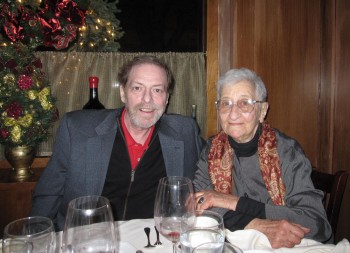 Forty years ago, on Tuesday Oct 10, 1972, 1 had just started my second day in animation working for John and Faith Hubley. I was scheduled to work three days to help finish a commercial. Helen Komar was the only other person working on that commercial with me. She was the production coordinator. My second day there, and I was working as intensely as 1 could. 1 loved being there, I was finally doing animation and getting paid for it.
Forty years ago, on Tuesday Oct 10, 1972, 1 had just started my second day in animation working for John and Faith Hubley. I was scheduled to work three days to help finish a commercial. Helen Komar was the only other person working on that commercial with me. She was the production coordinator. My second day there, and I was working as intensely as 1 could. 1 loved being there, I was finally doing animation and getting paid for it.
That day, 1 continued to work through my lunch break; I wanted to get it right. That’s when T heard this voice with a sharp Hungarian accent say loud enough, “Who has been doing such HORRIBLE inbetweens?” Sheepishly I looked up and had to admit that we all knew she was talking about me. Especially since I was the only one doing inbetweens. That’s how I met Tissa David.
Tissa proposed I come to take lessons from her; she would help teach me what she could about animation. This meant I spent a lot of time doing homework that Tissa would give me inbetweening over and over and over again animation drawings that were usually from a scene that Grim Natwick had animated. Back then, Tissa had a sharp way of telling you how bad you were. It didn’t take me long to find the humor in what she had to say, especially since 1 was even more of a critic of my own work than she was.
Things changed a bit over the years. Tissa grew more and more reserved with her opinions. She made an obvious attempt to moderate herself when she thought it was too harsh. However, I always tried to encourage her to fully express what she thought about my work, and I like to think she was honest with me throughout.
Somewhere along the line I stopped asking for help with animation. Slowly we became more friends rather than teacher and student. When she left the Hubley studio to work for Richard Williams on Raggedy Ann, knowing full well that I was a big fan
of Dick Williams’ work, she maneuvered a job for me on the production. Starting as an inbetweener, I worked my way up to the position of head of Assistants and Inbetweeners.
After that, I was hired by Bob Blechman to be his Asst Director working on a Christmas Special. Before we got to that we did a number of commercials together. Once Bob had difficulty finding an animator, and 11 talked loudly and enthusiastically about Tissa’s work. She soon started working with Bob in a relationship that lasted years.
When I formed my own studio, I directed a number of half hour shows. Tissa was happy to work for me in many capacities. She did storyboard, layout and sometimes animation. We helped each other often by just being there. That made a lot of the jobs more fun, and helped me feel even more proud of the work I was doing.
The last couple of years weren’t about animation, really. Yet the two of us were able to keep laughing throughout. And talking. Talking about museum shows and films that we saw. Sharing books we’d read or just sometimes talking. I was never much of a phone person so it had to be face on.
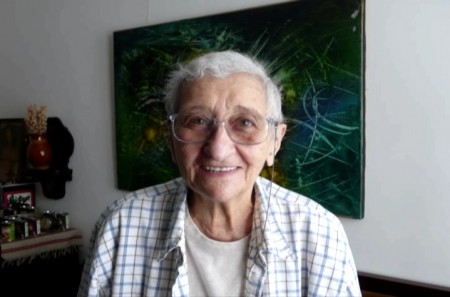
Tissa in her Living Room
Photo by Mate Hidvegi
In the end 1 learned that Tissa had developed a brain tumor. Of course, I didn’t know whether that meant she would have a long slow death or a quick one. 1 went one Saturday afternoon and laughed quite a bit with Tissa. When I brought up old names and places and events, she remembered them clearly. If she tried to remember something, she couldn’t, and the conversations would end flat. It meant I had to keep talking.
I left that afternoon and expected to return five days later. But that day I got a call from Susan Davis telling me that Tissa had died that day. She didn’t feel well in the morning, lay down for a while, and didn’t wake up.
I think her passing won’t really hit me for a while. I’ve been spending a lot of time editing this footage. Now this memorial is done, and I think the reality won’t hit home until Christmas. Every year, I’ve received a wonderful fruit cake from Tissa. In fact, I still have a couple unopened. I know that one won’t arrive this year, and I’ll miss my fruitcake this year.
This talk was followed by the last animation work Tissa did,
part of the animatic for my feature, POE.
.
.
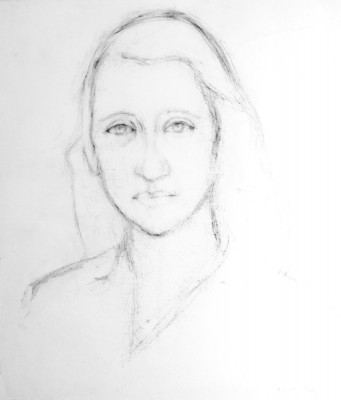 1
1
a 1942 drawing by Tissa’s close friend, artist,
Judit Reigl. The drawing is in the collection
of Tissa’s sister, Katalin David.
Thanks to Mate Hidvegi, Katalin’s son, for sending it.
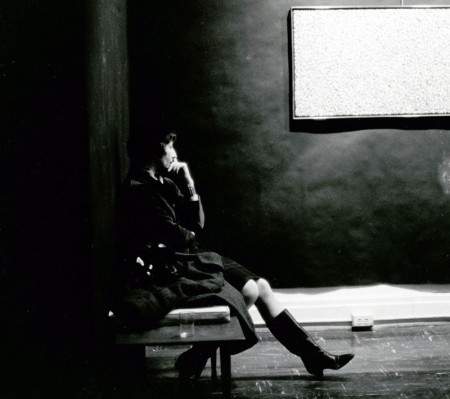 2
2
Tissa in an Art Gallery in the 60s
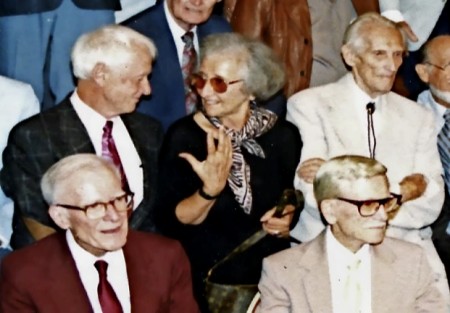 3
3
At Grim Natwick’s 100th birthday
(L to R) Duane Crowther, Tissa, Grim Natwick
in front of them: Frank Thomas, Virgil Ross
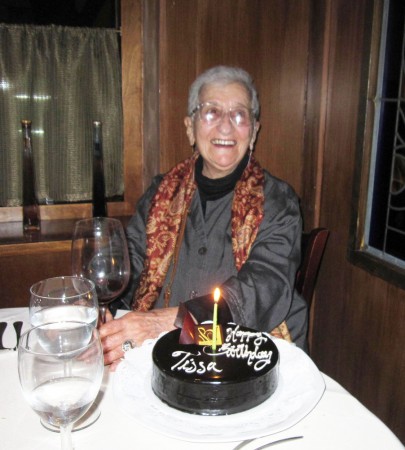 4
4
Tissa on her 90th birthday celebration dinner
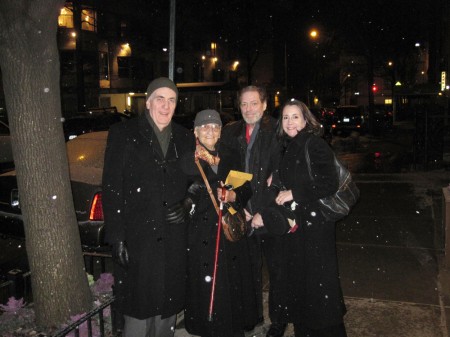 6
6
(L to R) John Canemaker, Tissa, Me, Heidi Stallings
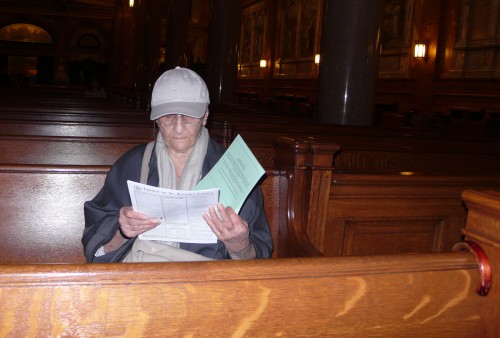 7
7
Tissa in St. Ignatius Loyola Church, 84th St, Madison Ave.
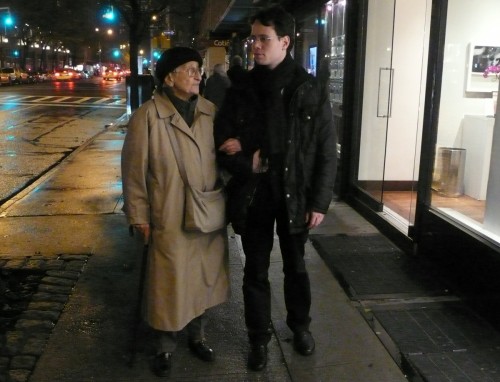 8
8
Tissa with Aron Hidvegi, her grand nephew
4, 5, & 6 photographed by Joe Kennedy
7, 8, 9, 11 & 12 photographed by Mate Hidvegi
10 photographed by Aron Hidvegi
Commentary 20 Oct 2012 06:37 am
Acorns
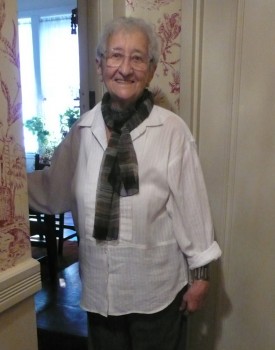 - We’ve planned a memorial for Tissa David that will take place in New York at the Academy Lighthouse Theater on Tuesday October 23rd at 7pm. The program will include five speakers and will have a fair share of clips from the many films Tissa animated. The studios that will be rimarily represented include: The Hubley Studio, Raggedy Ann & Andy, R.O.Blechman/The Ink Tank and Michael Sporn Animation.
- We’ve planned a memorial for Tissa David that will take place in New York at the Academy Lighthouse Theater on Tuesday October 23rd at 7pm. The program will include five speakers and will have a fair share of clips from the many films Tissa animated. The studios that will be rimarily represented include: The Hubley Studio, Raggedy Ann & Andy, R.O.Blechman/The Ink Tank and Michael Sporn Animation.
The films will include: Eggs, Everybody Rides the Carousel, Cockaboody, Raggedy Ann & Andy, Candide, The Soldier’s Tale, The Red Shoes, Lyle Lyle Crocodile, The Marzipan Pig, The Dancing Frog and POE.
Where: Academy Lighthouse Theater, 111 East 59th Street, lower level
When: Tuesday, October 23rd, at 7PM
Photo by Mate HidvegiAdmission: free
Seating: first come, first served
It’s been very interesting for me to prepare all this material for the program. As a matter of fact, just developing the program has been interesting.
In the last month or so, working out of Buzzco studio, I watched Candy Kugel and Rick Broas prepare the material for their ASIFA East program celebrating the work of Perpetual Motion Studios, a commercial animation studio where a number of people got their start. A lot of film had to be prepared for DVD projection and people had been organized to act as a panel where they would reminisce in front of the audience that came to see the show. Essentially, what Candy and Rick were doing was developing a theatrical program of mixed media which would celebrate this studio and hopefully entertain the audience that came to revisit the studio, one that meant a lot toone contingent of NY animation workers and was a curiosity for younger workers. The organizers of the event not only wanted to reunite with old friends, but they wanted to entertain an audience at the same time.
For me, it was quite informative watching all the work that went into the program as well as seeing the final results and assessing what, to my mind, worked or didn’t work.
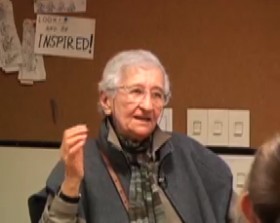 Now I’m doing something similar. I’m working a lot of material from Tissa David‘s life into a program that will hopefully entertain an audience while impressing them with the enormous talents of the woman who’d so affected my life. In short, I’ve been trying to develop a mixed media theatrical event, but I’ve been hoping not to let Tissa down since this will be the final farewell to her for many of those who will come. Needless to say, it won’t be my final farewell to her. She’s been a great and close friend, an animation wizard and something of a cherished advisor on many things. She was always there to talk to, to share films with and to chat about animation as well as our lives. Her memory is more than alive in the front of my mind.
Now I’m doing something similar. I’m working a lot of material from Tissa David‘s life into a program that will hopefully entertain an audience while impressing them with the enormous talents of the woman who’d so affected my life. In short, I’ve been trying to develop a mixed media theatrical event, but I’ve been hoping not to let Tissa down since this will be the final farewell to her for many of those who will come. Needless to say, it won’t be my final farewell to her. She’s been a great and close friend, an animation wizard and something of a cherished advisor on many things. She was always there to talk to, to share films with and to chat about animation as well as our lives. Her memory is more than alive in the front of my mind.
In short, I want to get this show right. That is, after all, what I am doing . . . putting on a show.
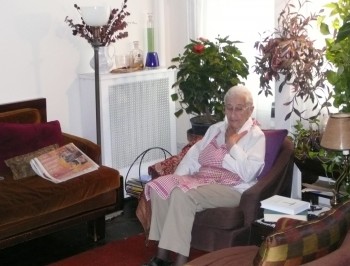 For the past week I’ve been working and reworking clips that’ll be screened, and going through many, many still photos of Tissa and her artifacts to prepare a little slide show that will get the crowd into the right mood as they enter the theater. Once you pick out the right pictures to present, there’s a delicate order to select them, tie them to a piece of music and try to create a short bit of a movie. Speaking of music, that alone is something difficult
For the past week I’ve been working and reworking clips that’ll be screened, and going through many, many still photos of Tissa and her artifacts to prepare a little slide show that will get the crowd into the right mood as they enter the theater. Once you pick out the right pictures to present, there’s a delicate order to select them, tie them to a piece of music and try to create a short bit of a movie. Speaking of music, that alone is something difficult
Photo by Mate Hidvegi to select. Certainly, with Tissa,
it meant sticking to classical as opposed to
popular music. Even then, I knew she didn’t like Beethoven so I couldn’t use “Ode to Joy,” for example. (Wouldn’t that have made some kind of memorial song!) I listened to a lot of Kodaly and pulled back since I’m not crazy about his music, I didn’t want anything at all Romantic. I listened to a lot of music that I like. No, I’d be too tempted to pull something from John Adams or Phillip Glass’ catalog. That most definitely is not Tissa. Ultimately, I settled on Bach. I found a nice version of his prelude from Bach´s Cello Suite No. 1 as performed by Yo Yo Ma.
I want to offer a giveaway to the audience, a little program that they’ll have for review after they’ve left. The slide show has been completed (and I think successfully), and the decisions for all the cuts and clips have been made for the screening, and all the speakers have sent me their pieces on Tissa. Now I have to write a program and will have to get a couple hundred copies printed over the weekend.
All in all, it’s been a formidable month, this last one. A lot’s been done, and I’m looking forward to the event. I just worry a bit that now I’ll have to say goodbye to Tissa.
Order of Merit to Tissa’s Sister
 - On the 56th anniversary of the 1956 Hungarian revolution the memorial conference was held.
- On the 56th anniversary of the 1956 Hungarian revolution the memorial conference was held.
Yesterday, one of Tissa’s sisters, Szaniszla, was decorated with a very highly prestigious medal – Order of Merit of Hungary.
After the revolution in 1956, Szaniszla was jailed because she participated and supported the revolution.
(Tissa had escaped Hungary and fled, ultimately, to Paris some seven years earlier in 1949.)
Why Obama Now
I saw this excellent piece of anmation on the Animation Guild Blog this past week, and I couldn’t help but pass it forward. Lucas Gray did a fine job of illustrating a talk by Barack Obama and executed it with style and intelligence. It’s a flash work that exploits the program for all it’s got. If John Sutherland were making films today, this is probably what they’d look like.
Hans’ Dream
- Hans Bacher in a new post on his site, one1more2time3, is invading Eddie Fitzgerald territory with an imagined construction, a dream of the future from a child of the past if he had this present. A peculiar description, but it’s probably apt. Take a look for yourself.
A Dancing Kickstarter
I received this note this week and found it interesting enough to post:
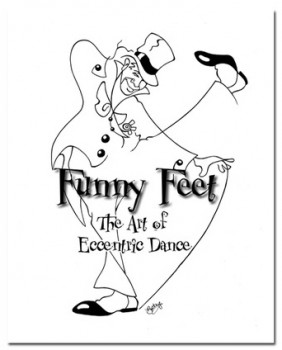 Hi Michael,
Hi Michael,
My name is Betsy Baytos and my colleagues, I am writing to see if you could kindly help post my Kickstarter Film project, on your site and blog. ‘
FUNNY FEET: The Art of Eccentric Dance‘
A brief introduction: A former Disney Feature Animator and Eccentric ‘comedic’ Dancer, my work now focuses on animation choreography (i.e.:’Emperor’s New Groove‘ & ‘Princess and the Frog‘). I have also performed as the Muppet Show’s ‘Betsy Bird’, teaching/lecturing Eccentric ‘character movement’ at Disney and Cal Arts animation classes, Oxford University’s ‘Fred Astaire Conference’,consulting for Cirque Du Soleil, Universal Studios Japan and the Ringling Bros. Alumni.
I have just launched a Kickstarter campaign to finance the completion of my film research, for a Documentary, ‘FUNNY FEET: The Art of Eccentric Dance‘, with over 45 celebrity filmed interviews:(i.e.: Red Skelton, Jerry Lewis, Dick Van Dyke, Shirley MacLaine, Mrs. Buster Keaton, Chuck Jones, Al Hirschfeld, Joe Grant, Ward Kimball, Joe Barbera, Frank & Ollie, Myron Waldman, Richard Fleischer and many more….) All with a focus on how eccentric dance inspired the visual arts and especially animation, as many of the great eccentric dancers were models for our most beloved cartoon characters. .
My entire research & film collection will be donated to the Motion Pic Academy of Arts & Science here, as a final home when all is said & done.
To see the Kickstarter proposal go here.
NY – Comi Con – NY
Tom Hachtman is a good friend. I love his art work and have supported it from the time I first saw his comic strip, Gertrude’s Follies, in the SohoNews, an extant paper from the lower rungs of Manhattan’s coolest neighborhood. Tom and I spent a lot of time storyboarding a very low budget animated feature pulled from his strip. If nothing else it made me laugh for months while we were drawing it.
Well, Tom was at the NY version of the ComiCon held Oct. 11-14 at the Javits Center on NY’s far West side. Tom was promoting a couple of books Gertrude’s Follies, Fairly Grim Tales (which he illustrated). I’m pleased that Martin Kozlowski pushes to keep Tom published; obviously the man has good taste.
Tom wrote a funny account of his four days there:
- I was there for all four days of the event that opened Thursday 10/11/12.
Directly across from us there was a booth promoting something called ‘The Mr. Gray show. They were showing (on a laptop) a pilot episode that included an interview with David Lynch where he talks about his Jack Russell terrier Sparky. There is some ANIMATION at the beginning.
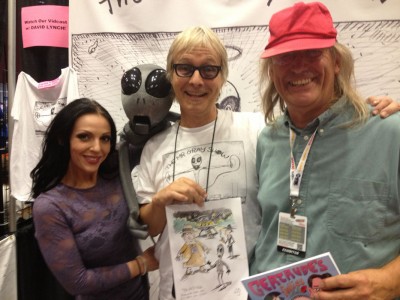
(LtoR) Salvina Vitali starring as Agent BJ, Mister Gray the alien puppet
from planet Zeb, the show’s creator Dusty Wright holding a drawing of
Gertrude and Alice meeting Mr. Gray, and, in the red hat, yours truly.
For four days I watched a parade of comic book fans in costumes depicting their favorite characters. I don’t know who these people are and I often don’t know who the character is they have dressed up as. Day four Larry pointed out an approaching Poison Ivy and said, “You must be tired – you don’t even look.”
Then along came Red Sonja to put me out of my misery – best shot of the day.
Since I love redheads I had my picture taken with Poison Ivy, Black Widow, Red Sonja and many more terrifying creatures I can not identify.
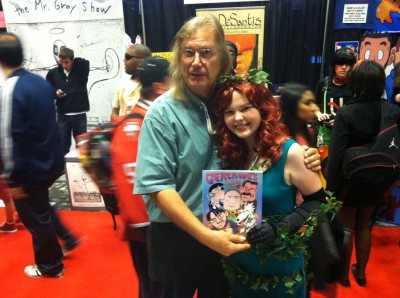
w/Poison Ivy
Anyone who bought a book got a drawing. Here are a few that I didn’t give away.
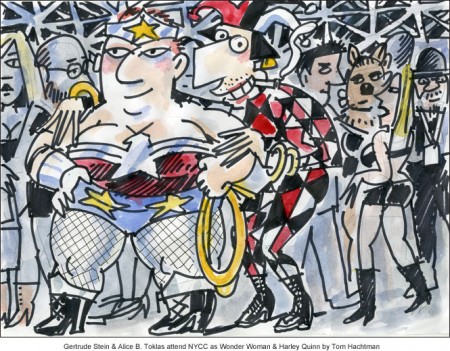
Gertrude and Alice at Comic Con dressed as Wonder Woman and Harley Quinn –
these were two very popular costumes at Comic Con.
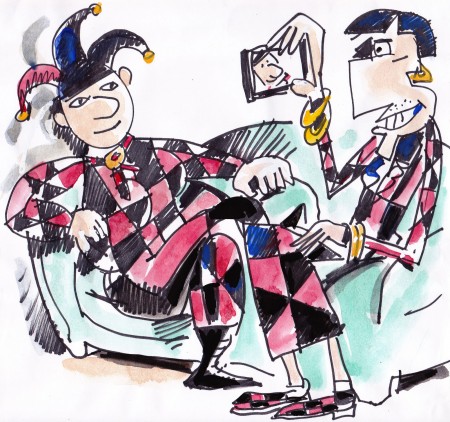
Alice taking a photo of Gertrude with her iPhone –
both in Harley Quinn costumes.
Commentary 06 Oct 2012 07:29 am
Effectively Functioning
Predominantly, I’ve been completely absorbed by two things. Tissa David‘s memorial is just about organized. The rough cut of the film program has been assembled, and I’ll hand it off to my favorite editor, Paul Carrillo, who will add some rhythm and grace. Tissa deserves that much from me.
I need to thank Candy Kugel for offering her facility to put this together. It was a lot of work. Thanks also to Rick Broas for doing so much of the technical work that I have no facility to handle. He does and did it with a lot of patience and positive energy.
Other than that I am wholly focused on the introduction to POE, my feature film trying to find a start. I’m completely entrenched in these scenes and work them over and over trying to find the right way to give them birth. I love it and look forward to getting financing soon to really get it under way.
A lot, other than that, has had to do with scanning and planning for this Splog. Today I put together a gem of a piece. We found some incredibly rare pieces among Vinnie Cafarelli‘s archive of material. Some Fleischer and Famous leftovers were found and prove amazing. Look forward to that this coming Wednesday.
Signe’s Rocks
Signe Baumane has one of my favorite blogs on the internet, and I’ve been writing about it for years. She is such a unique and individual writer, and there’s a lot to be gained from reading what she has to offer. Every Tuesday she writes about her film in production, about her depression (the subject of the film), about her life and about art & animation in general. It’s always a good read.
Signe is primarily an animation artist who’s done some half dozen films and is now working on her magnum opus, a feature length animated film called Rocks In My Pockets. This week, on her blog she wrote about a trailer just completed and she posts that trailer. The film combines 3 dimensional backgrounds for many sections under the 2D animation. It has a great look and has me patiently waiting to see more and more until I can finally see the whole film. The trailer doesn’t include any of the 3D backgrounds, which I’m sorry to report. That is such a good look with constructed backdrops that have a distinct style that makes the film look very rich. I feel like she might be underselling it with only the 2D art. You can see samples of the look on some of her past posts (e.g: here and here and you can read about the set design and construction here).
Anyway, here’s her trailer:
WORK IN PROGRESS TRAILER from Signe Baumane on Vimeo.
You can read her blog about the making of the trailer here.
Signe is financing the film on a wing and a prayer. She often writes about the problems of fund-raising on the blog. She’s built a “Donate” button into her website in case you want to send her $10 or $1000 (or anything above, below or inbetween those amounts) to help out. I heartily recommend you do this if you can spare a couple of dollars. You’ll be supporting the arts and a project well worth investing in. A movie ABOUT something. Go to her website, Rocks In My Pocket here.
Events
- This was a busy week. Something was happening almost every day, to the point where I was punking out of some of them.
Sunday there was a party at Amid Amidi‘s office space in honor of Priit Pärn visiting
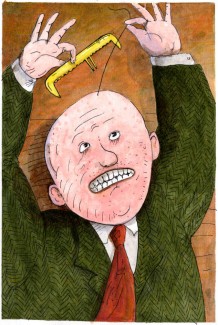 from Estonia. I hadn’t met Priit in the past at any festival. Id only seen about four or five of his films, but I have to admit that I’m not that big a fan. His work is somewhat chaotic and not really “character” animation. Stylistically, he never pulls me in and the substance is a bit too dense for me to the point of impenetrable. I always give the blame for such to myself for not being able to figure out what the filmmaker is trying to say, but when it happens with every one of the filmmaker’s films, I heed the warningand usually back away. That, I’m ashamed to say, is the case with me and Mr. Pärn’s films.
from Estonia. I hadn’t met Priit in the past at any festival. Id only seen about four or five of his films, but I have to admit that I’m not that big a fan. His work is somewhat chaotic and not really “character” animation. Stylistically, he never pulls me in and the substance is a bit too dense for me to the point of impenetrable. I always give the blame for such to myself for not being able to figure out what the filmmaker is trying to say, but when it happens with every one of the filmmaker’s films, I heed the warningand usually back away. That, I’m ashamed to say, is the case with me and Mr. Pärn’s films.
It was a pleasure meeting him, though. He’s truly a sweet man, and was very affable. I hadn’t heard in years from another Estonian, Rein Raamat, and was able to ask Priit if he knew what had happened to the older man. I knew he’d retired years back, but there’s only been silence, and I was afraid he’d died. No, it turns out he’s just retired. You could sense the discomfort there was in talking about the older man. Priit Pärn felt as though he were backing away while answering my questions. I imagine that’ll be the case when someone asks what had happened to me as I go off into the sunset drooling over my favorite Disney collectible.
The party Amid threw was great. A great crowd of people kept it entertaining, to say the least. John Canemaker & Joe Kennedy, George Griffin, Debbie Solomon, Candy Kugel, Emily Hubley with husband, Will Rosenthal, Leah Shore, Richard O’Connor, Liesje Kraai, and,of course, Celia Bullwinkle. There were, naturally enough, plenty of others, but these are they who pop into my mind as I write away.
Many thanks to Amid for hosting the fine event.
On Tuesday, The Princess Bride got a grand resuscitation from the New York Film
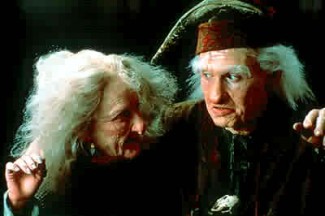 Festival as it honored Rob Reiner’s live action fairy tale. Actually it was an Academy reconstructed print, which is why I was invited. I’m not a fan of the film and had a hard time sitting through it again, but the Q&A was everything that night. On stage was director, Rob Reiner, writer, William Goldman, actors Cary Elwes, Robin Wright, Billy Crystal, Wally Shawn, Mandy Patinkin, Chris Sarandon, and Carol Kane. Rob Reiner was affable but slowly trned into a ham then a pig as he started to answer questions even when others were called upon to respond. He was oblivious to the audience laughing AT him at a couple of points. Billy Crystal, on the other hand, was truly funny. He kept everything moving smoothly with a great sense of humor. Mandy Patinkin was gracious honoring André the Giant the Giant who’d died in 1993. The hot spot was Cary Elwes who had a charming sense of humor with a number of funny bits.
Festival as it honored Rob Reiner’s live action fairy tale. Actually it was an Academy reconstructed print, which is why I was invited. I’m not a fan of the film and had a hard time sitting through it again, but the Q&A was everything that night. On stage was director, Rob Reiner, writer, William Goldman, actors Cary Elwes, Robin Wright, Billy Crystal, Wally Shawn, Mandy Patinkin, Chris Sarandon, and Carol Kane. Rob Reiner was affable but slowly trned into a ham then a pig as he started to answer questions even when others were called upon to respond. He was oblivious to the audience laughing AT him at a couple of points. Billy Crystal, on the other hand, was truly funny. He kept everything moving smoothly with a great sense of humor. Mandy Patinkin was gracious honoring André the Giant the Giant who’d died in 1993. The hot spot was Cary Elwes who had a charming sense of humor with a number of funny bits.
The afterparty was a bust. Loud, overcrowded and irritating it didn’t take long for me to leave. They sent us away with a Goody Bag that included a book of the script filled with scrap from the film lots of stills, artwork of the sets and plenty of information if you’re a fan. They also gave us a T-shirt and as well as a Blue Ray copy of the movie. (I still don’t have a player) I was pleased to give away the bag to someone who really appreciated it.
 Wednesday was the height of the week – a TV night. The Yankees were playing for the championship of the AL East. If they won they got it; if the lost and Baltimore won they were just a team with a one-game playoff to go on Thursday. Yankees won, Baltimore lost.
Wednesday was the height of the week – a TV night. The Yankees were playing for the championship of the AL East. If they won they got it; if the lost and Baltimore won they were just a team with a one-game playoff to go on Thursday. Yankees won, Baltimore lost.
Then the highlight of the night. The first Presidential debate aired from Colorado. Romney got the chance to look Presidential as he stood alongside the real President. The format went out the window as Romney ignored Jim Lehrer and fought him time after time after time. Obama curled up into a ball and didn’t fight for what he believed in. Romeny just kept lying and changing his opinion on everything. He’s been politicking on a tax cut for the rich these past 9 months, now he says that that’s not what he’s doing. I give up. Obama just stood there with his head down taking notes, for some reason. I got so frustrated by his performance that I was about ready to change the channel.
At least the Yankees knew how to win.
Thursday saw two films: The Paperboy starred Matthew McConaughey, Zac Efron, John Cusack, and Nicole Kidman. Lee Daniels directed his second film. (Precious was his first two years ago.) This film was a mess and tried so hard to be an artfilm. Trashy characters mix with each other until half of them are dead. Macy Gray was one of the only spots of dignity in it.
and
The Eye of the Storm is an Australian film starring Geoffrey Rush, Judy Davis, and Charlotte Rampling. It was directed by the pro, Fred Schepisi. This was a very well acted film. Judy Davis was near brilliant even though the script wasn’t as strong as it might have been. I really found enjoyment with the interplay of the characters and the actors who inhabited them.
I saw Bill Plympton at this screening and invited myself to his loft to say hello to his newborn baby boy. I’ll try to make it there this week.
Lots of screenings and parties and whatnot are on the schedule for the next week or so. I’m amazed with how much the Academy has been involved in the New York Film Festival this year. I’m also pleased with it.
Frankenweenie Reception
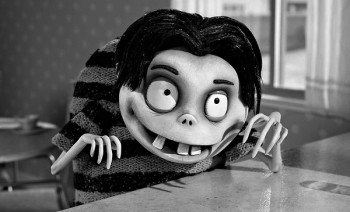 Frankenweenie opened in NY yesterday, though I won’t get to see it until next Thursday (and will review it after I see it.) The film received some of the best reviews this year for an animated feature. Nationally, Rotten Tomatoes gives it an 85% rating.
Frankenweenie opened in NY yesterday, though I won’t get to see it until next Thursday (and will review it after I see it.) The film received some of the best reviews this year for an animated feature. Nationally, Rotten Tomatoes gives it an 85% rating.
Elizabeth Weitzman in the NYDaily News gave it four **** stars and called it a “Frankenweenie Delight.” The lst lines of the review are: “Despite the gently macabre tone, there are no gratuitous scares or elbow-nudging ironies. Just a witty, warm appreciation of cinema, science and the creativity of childhood.
___________________________________________What a rare and welcome treat.”
A.O. Scott in the NYTimes praises the film lightly but pulls back at each bit of praise. “The delights of “Frankenweenie†are abundant and real. Its opening scenes are beguiling in their strangeness, and its climax is wild and hilarious. But the movie, a Walt Disney release, also feels tame and compromised, a tissue of safe pop-culture allusions rather than an inspired, audacious engagement with older movies.”
Lou Lumenick in the NYPost gives it 3½ stars and fine praise. “‘Frankenweenie’’ is Tim Burton’s best film in years. With this expanded, beautifully realized and highly entertaining animated version of his famous 1984 live-action short about a young loner and his resurrected dog, Burton, whose films have gotten progressively more overblown and overproduced, goes back to ghoulish basics. It’s an endearingly modest and affectionate tribute to the classic 1930s monsters and their influence on daydreaming kids like Burton who grew up in suburbia four decades later.”
The Village Voice‘s Chris Packham has only high tribute to the film. “Frankenweenie Awakens the Pleasures of Reanimation” “Frankenweenie . . . is tight and brief, hitting all the marks you’d expect from an animated kid’s film, and enlivened by Burton’s visual style. The man should make more small movies like this one.”
One wonders what will happen to Adam Sandler‘s successful feature, Hotel Transylvania. (Interesting that I instinctively tought of this as Adam Sandler’s film and not Genndy Tartakovsky‘s film.) Will Frankenweenie kill this or vice versa? We’ll know by Sunday.
Hubley Films
- There will be an extensive program of Hubley films screened at The Museum of Arts and Design on Friday, Oct. 19th. The films to be screened are a large mix of those done by John, Faith and Emily Hubley. They include:
- Adventures of an Asterisk
1957, Dir. John & Faith Hubley
The Hat
1964, Dir. John & Faith Hubley
Eggs
1971, Dir. John & Faith Hubley
Cockaboody
1973, Dir. John & Faith Hubley
The Tender Game
1958, Dir. John & Faith Hubley
Time of the Angels
1989, Faith Hubley
Her Grandmother’s Gift
1995, Dir. Emily Hubley
Witch Madness
2000, dir. Faith Hubley
Pigeon Within
2000, dir. Emily Hubley
Northern Ice Golden Sun
2001, Dir. Faith Hubley
Set Set Spike
2002, Dir. Emily Hubley
And/or
2012, Dir. Emily Hubley
details:
The Museum of Arts and Design
2 Columbus Circle, New York, NY 10019 on
Friday, October 19, 2012 – 7:00 pm
$10 general / $5 members and students
New Savannah

A photo by Bill Benzon which seems to work exquisitely on his site.
- Bill Benzon continues with some of the most intellectual theses and conversations on his blog, the New Savannah. Recently, I directed you to a lengthy piece about Dumbo which Mr.Benzon had reworked into a PDF which was available for the clicking.
Lately, he has written about many big concept ideas such as the lack of cartoon animals as a stand-in for humans in modern animation. Where’d the Animals Go? discusses this subject in earnest. From South Park to UP to the Simpsons to Brave, humans dominate. Animals are animals, as in How to Train Your Dragon.
He’s written about Cuteness (the Infant Schema). An analysis of Tweety and other big-headed, big eyed, sweet characters.
He’s written about Ratatouille and the discussion of man, vermin and food. This has stretched on to three nice-sized posts. In fact this is the heart of this film, and it’s quite adroit of Bill Benzon to go directly to that place to discuss the subject. This, it seems to me, is what he often does.
It’s also what makes his blog a regular read for me. (I also love many of the photos he posts along the way.) This is a site unlike any other. Intelligent conversation about cartoons. No, it’s not about how many lines Bugs Bunny ahs on the back of his gloves from cartoon to cartoon, but it talks about the abstract. Considering that all cartoons and cartoon characters are abstractions, it’s interesting that there are no others like this blog.
I’ve had a rare few of my films given the intellectual approach in reviews. A scholar of Hans Christian Andersen‘s tales delved deeply into a number of my updated Andersen tales and he gave them a quite positive review in his two books on the subject. These were done without my knowledge; I learned of them only when a reviewer’s copy arrived in the mail compliments of the author. I have to say these are the reviews I most treasure. The analysis of the thoughts that went into the films. Someday, perhaps, Bill Benzon may take some interest in my work. (hint, hint)
Commentary 22 Sep 2012 06:53 am
Criticeria
- It appears that a number of animated features will be opening shortly. There’s a screening in NY this morning of Hotel Transylvania. It’s at the Museum of the Moving Image in Queens. That’s a long enough trip to keep me from going. I’ll see it another time; the ad keeps me uninterested. It opens next friday, Sept 28th.
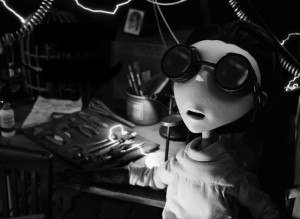 The Academy will screen Tim Burton’s Frankenweenie on October 11th, a week after it opens in theaters. I’ll see it there, in comfortable surroundings.
The Academy will screen Tim Burton’s Frankenweenie on October 11th, a week after it opens in theaters. I’ll see it there, in comfortable surroundings.
There’s an article about Tim Burton in today’s NYTimes.
Wreck It Ralph opens November 5th. Can’t wait.
There’s no real incentive for me to see any of these films except that they’ll all be entered into the Oscar race, and to vote I’ll have to see them all. The more I can see now, the fewer I’ll have to see in that crushing two weeks at the end of the year. That’s when all of the entered films have to be viewed. It’ll be something like 16 films in two weeks to absorb. Talk about impaired judgment.
The contenders for animation short will be screened n NY on Saturday, Oct. 27th. That’ll start at 10am and probably go straight through to about 6 or 7pm. Your eyes are melting by the time you get out of there, with maybe one or, at the most, two good films in the bunch.
I still look forward to it all.
My World and Welcome To It
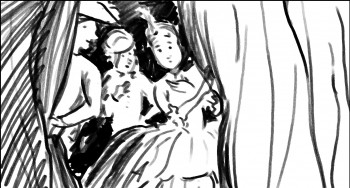 - Meanwhile, Heidi, my wife, says my world is all about politics and movies. She’s wrong; baseball is high in there as well. This time of the year, particularly an election year like this, I only want to watch talking heads on TV (and The Good Wife and Treme and Boardwalk Empire.)
- Meanwhile, Heidi, my wife, says my world is all about politics and movies. She’s wrong; baseball is high in there as well. This time of the year, particularly an election year like this, I only want to watch talking heads on TV (and The Good Wife and Treme and Boardwalk Empire.)
Actually, I don’t think about much of this. I do think about POE and the scenes I’ve been anmating over and over and over. The style is a bit funky and I keep reworking it. I have four scenes done, and I keep expecting more of myself, so I keep redoing them. If I’d been doing it on cel with an animation camera, the first version would have been the final. But using a computer means I can rework the damn thing a hundred times or more. It’s fun though. I want to have the thing down pat before I really get into it. Once the real “Go” is there it means Go.
By the way, the title, My World and Welcome To It, of course, comes from that great series from 1969 which starred William Windom as a James Thurber-like cartoonist whose animated imaginings filled the screen throughout the show. I was in Alaska in the Navy when it aired in the lower 49. I might have been able to see Russia from my house, but the TV didn’t run this series. My sister talked about it in her letters and I did a lot of catching up when I got home.
I was reminded of the show recently when Windom died in early August. I was a fan of his before that series, and I became more of a fan after the series.
Robert Dranko was the animation art director and producer for the series and
Bob Richardson was the animation director.
Ottawa
 - The Ottawa International Animation Festival began this past Wednesday. I’ve always felt close to this Fest. Having gone to the first half dozen versions of this event, where I learned so much about International film and the job of selling movies, that it naturally formed a soft spot for me. With sadness and regret, I couldn’t make it up to attend in person. However, I do keep my eyes open to see what’s happening there and what I’m missing. Richard O’Connor, through his site, Ace and Son, has always been a source of information that’s been invaluable to me. This year Richard helped open the first program by presenting a reel of short clips and an articulate eulogy for Tissa David. On his report of the first day of the Fest, he posts a video clip showing his comments during that program. You can check in daily for his comments.
- The Ottawa International Animation Festival began this past Wednesday. I’ve always felt close to this Fest. Having gone to the first half dozen versions of this event, where I learned so much about International film and the job of selling movies, that it naturally formed a soft spot for me. With sadness and regret, I couldn’t make it up to attend in person. However, I do keep my eyes open to see what’s happening there and what I’m missing. Richard O’Connor, through his site, Ace and Son, has always been a source of information that’s been invaluable to me. This year Richard helped open the first program by presenting a reel of short clips and an articulate eulogy for Tissa David. On his report of the first day of the Fest, he posts a video clip showing his comments during that program. You can check in daily for his comments.
Memorial
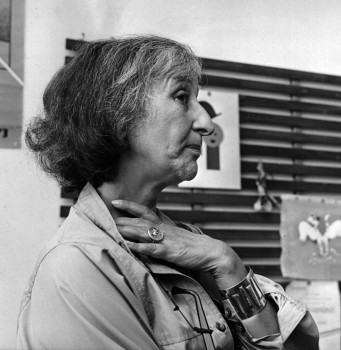
- Meanwhile the NY memorial for Tissa David is coming along nicely. It will definitely take place at 7pm on October 23rd at the MP Academy screening room at the Lighthouse at 111 East 59th Street. The theater is downstairs. It may be crowded and first come first seated.
There will be five speakers and lots of film clips.
I intend to screen at least one or two complete films, but time may nix that plan.
The films to be screened come from four studios:
- . the Hubley studio – EGGS, COCKABOODY, EVERYBODY RIDES THE CAROUSEL and possibly a commercial or three
. the Ink Tank/R.O.Blechman – THE SOLDIER’S TALE, CANDIDE promotional film, a commercial or two
. Raggedy Ann and Andy – “Candy Hearts and Paper Flowers” sequence
. and my studio – THE RED SHOES, THE DANCING FROG and THE MARZIPAN PIG (of course).
There’s also a nice surprise which will start the evening and the program.
It should be excellent.
Let’s Celebrate The Tune
- There was an article about Bill Plympton in last week’s The Onion. No it wasn’t a joke, it was a fine article in the AV Club section of the paper. This is a good article by Tasha Robinson and is worth the read. It basically celebrates the one-man-feature idea of The Tune done in 1997. He was a pioneer, I have to hand it to him. Worth the read.
Commentary 22 Aug 2012 08:03 am
Tissa David 1921-2012
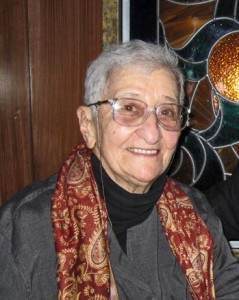
Tissa David was 91 last January.
Tissa David died last night.
In the past month, it was discovered that Tissa had a tumor which formed on her brain and was growing rapidly. She went home from the hospital, rather than experience a difficult operation, which she, at the age of 91, wouldn’t survive. It would be better to go out gracefully.
I visited her several times a week, if I could. Our conversations amounted to my being as cheerful as possible remembering as much as I could and discussing old friends and good times. I tried to sound as gossipy as I could, and Tissa enjoyed that. We also talked about animation: the mechanics of animation and different styles of animation. Her memory was clear as long as I was talking. When she tried to answer a question, the memory didn’t work, and Tissa would just say, “I don’t know. I don’t know.”
Last night, while I was out, her good friend and caretaker, Susan Davis, called leaving a message for me to return her call to Tissa’s apartment. I had intended to visit Tissa again today, Wednesday.
Tissa died yesterday evening, August 21st, in her Manhattan apartment at 7:35 PM.
To give some background information about Tissa David, I’m reposting this Millimeter article that John Canemaker wrote in 1975. I’ve added some to it.
- The 1975 issue of Millimeter Magazine is an animation issue. There are a number of enormously informative articles. I was rereading a copy of the magazine, this past weekend, when I came across the Close Up section, wherein a couple of bios appear.
I’d like to show one for Tissa David that was included. I assumed John Canemaker authored the piece; there is no byline. When I asked him, he responded thus: “I wrote the article on Tissa. The quotes are from my first formal interview with her. It was for Millimeter when I was the animation editor and put together special animation issues.”
Tissa looks so young in that photo.
-
“I am a frustrated comedienne, for sure,” Tissa David will tell you, only if you ask. “I am a clown. If I weren’t shy, I’d probably be on the stage.” Instead she is an animator, one of the world’s best and busiest, and one of the few women to have reached the top in the traditionally male-dominated animated cartoon field.
She joyfully toils in her East-Side New York apartment, a warm, plant-filled place that often smells of baked apples. Classical music swirls quietly from a radio and the glow cast from the light under her animation board gives her the look of a sorceress.
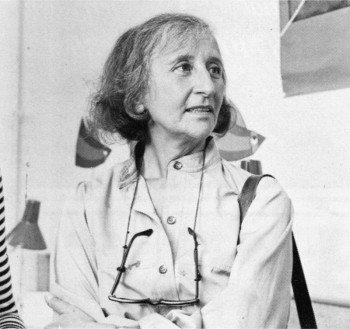 The lady has class—a fact one gathers upon first meeting, but a fact that is reaffirmed by catching a look at the creatures she is conjuring to life on her drawing board. The graphic line is strong and free, yet elegant (as is the artist); and when the drawings are flipped, the creatures move through their paces with a deliciously droll humor, a wit that is uniquely Tissa David’s.
The lady has class—a fact one gathers upon first meeting, but a fact that is reaffirmed by catching a look at the creatures she is conjuring to life on her drawing board. The graphic line is strong and free, yet elegant (as is the artist); and when the drawings are flipped, the creatures move through their paces with a deliciously droll humor, a wit that is uniquely Tissa David’s.
As a child in her native Hungary, Tissa saw Disney’s SNOW WHITE and thought (as so many others have thought after experiencing that film masterpiece), “Now this is something I want to do.” After graduating from art school, she became an assistant animator at Magyar Film Iroda in Budapest; a little more than a year later, in 1945, she was a co-owner of the Studio Mackassy and Trsi supervising all phases of production including story and camera and was sole animator of the puppet and cartoon films.
She left Hungary in 1950 during the height of the Stalin regime, and finally landed in Paris.
Jean Image Productions hired her in September 1951 and for two years she read sound tracks, planned layouts, animated, and did the entire editing of the feature-length, BONJOUR PARIS (1953). That studio closed and Tissa animated at La Comete next, a studio that had been Paul Grimault’s.
“I had absolutely no relatives outside of Hungary except in the United States. So I asked for a visa in 1950. It took at that time five years to get a visa, that was still the quota system. So I came to New York…I loved the U.P.A. cartoons. I decided I wanted to work in that studio.” In 1956, the United Productions of America’s New York Studio was the last tenant in a brownstone on Fifth Avenue and 53rd Street slated to be torn down for the construction of the 666 Tishman Building. There was a French girl in the UPA studio and so she introduced me,” Tissa recalls. “I had no sample reel. I went in once to make a sort of tryout. I was scared; I didn’t speak English, so I was just waiting, waiting, and Grim came by…Grim Natwick is the history of animation and I can rave about him. He created Betty Boop and animated the character of Snow White all the way through. UPA had an awful lot of work and they needed an assistant to Grim.”
At that initial meeting, Natwick boomed, “Now, you know what animation is!” Tissa quietly answered, “Animation is—animation.” Natwick laughed, “You can’t argue with that!” and thus began a professional partnership that lasted twelve years. “Isn’t it strange,” says Tissa today, “that SNOW WHITE got me into animation and I really learned my animation from Grim. I know a great deal about animation, I know I know, because even today I don’t do one line without something in my brain Grim told me.”
After UPA closed in 1958, Tissa and Grim freelanced as a team on countless TV commercials, and since Grim’s retirement, Tissa has soloed successfully and most notably on several John Hubley projects, i.s.: Of Demons and Men (1970), Eggs (1970), Children’s Television Workshop segments Cool Pool Fool, True Blue Sue, Truth Ruth and others, and Cockaboody (1973). Her latest animations include three CTW Letterman episodes, a scene in Shamus Culhane’s Noah’s Ark production, and over 110 feet of Hubley’s Bicentennial film, People, People, People. She has just completed some experimental animation fora Dick Williams project and is now starting, also for Hubley, a TV special based on Erik Erikson’s writings.
A description of Tissa David’s style of animation is difficult; for while it is a distillation of the Disney influence in timing, the UPA sense of humor-through-graphic-design, and the strong, poetic John Hubley mode, it also contains a different character, unique to Tissa David, that she calls the “female difference…If the same scene is animated by a man and by me, there will be a great difference, not in quality but in interpretation. John Hubley told me I have a fine sense for detail, not in the drawing itself because I make very loose drawings, but in a scene, in expressing feelings. I am a very intuitive animator—I never know when I sit down to work what will happen.”
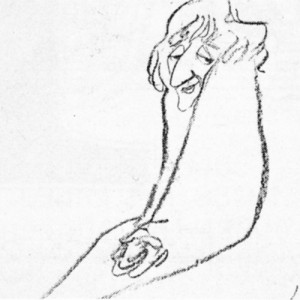 For all her gentleness, Tissa also contains an inner core of strength exhibited in her single-minded devotion to her art. Her opinions about that art, herself and other topics, is disarmingly to-the-point: “I believe very strongly that one must know how to draw,” she will offer on the subject of how-to-animate. “Even if you just animate objects, you must have a knowledge of drawing.” As for her struggles securing her place in animation, Tissa will admit, “…its very hard. Women can find work in animation if they have enough will to follow through and really do it. Even today, I’m always saying if I keep busy long enough, I will become a good animator.”
For all her gentleness, Tissa also contains an inner core of strength exhibited in her single-minded devotion to her art. Her opinions about that art, herself and other topics, is disarmingly to-the-point: “I believe very strongly that one must know how to draw,” she will offer on the subject of how-to-animate. “Even if you just animate objects, you must have a knowledge of drawing.” As for her struggles securing her place in animation, Tissa will admit, “…its very hard. Women can find work in animation if they have enough will to follow through and really do it. Even today, I’m always saying if I keep busy long enough, I will become a good animator.”
At the time this piece was written, Tissa was completing work on a pilot for Dick Williams’ film, Raggedy Ann & Andy; this one minute piece got Dick the film over Joe Oriolo and Shamus Culhane. She would thereafter work on John Hubley’s Doonsebury Special (just as he died mid film); and she was to animate for R.O.Blechman’s Simple Gifts.
Since that article was written, Tissa had animated a good part of The Soldier’s Tale for Bob Blechman. It won the EMMY Award. For me she worked on many of my half hour shows. The Marzipan Pig was made from her storyboard, and she animated the entire half hour film.
I’ll write a longer piece in a few days and will add some photographs.
Needless to say, this is very sad for me.
Articles on Animation &John Canemaker &repeated posts &Tissa David 22 Jul 2012 04:46 am
Tissa – 1975
- The 1975 issue of Millimeter Magazine is an animation issue. There are a number of enormously informative articles. I was rereading a copy of the magazine, this past weekend, when I came across the Close Up section, wherein a couple of bios appear.
I’d like to show one for Tissa David that was included. I assumed John Canemaker authored the piece; there is no byline. When I asked him, he responded thus: “I wrote the article on Tissa. The quotes are from my first formal interview with her. It was for Millimeter when I was the animation editor and put together special animation issues.”
Tissa looks so young in that photo.
-
“I am a frustrated comedienne, for sure,” Tissa David will tell you, only if you ask. “I am a clown. If I weren’t shy, I’d probably be on the stage.” Instead she is an animator, one of the world’s best and busiest, and one of the few women to have reached the top in the traditionally male-dominated animated cartoon field.
She joyfully toils in her East-Side New York apartment, a warm, plant-filled place that often smells of baked apples. Classical music swirls quietly from a radio and the glow cast from the light under her animation board gives her the look of a sorceress.
 The lady has class—a fact one gathers upon first meeting, but a fact that is reaffirmed by catching a look at the creatures she is conjuring to life on her drawing board. The graphic line is strong and free, yet elegant (as is the artist); and when the drawings are flipped, the creatures move through their paces with a deliciously droll humor, a wit that is uniquely Tissa David’s.
The lady has class—a fact one gathers upon first meeting, but a fact that is reaffirmed by catching a look at the creatures she is conjuring to life on her drawing board. The graphic line is strong and free, yet elegant (as is the artist); and when the drawings are flipped, the creatures move through their paces with a deliciously droll humor, a wit that is uniquely Tissa David’s.
As a child in her native Hungary, Tissa saw Disney’s SNOW WHITE and thought (as so many others have thought after experiencing that film masterpiece), “Now this is something I want to do.” After graduating from art school, she became an assistant animator at Magyar Film Iroda in Budapest; a little more than a year later, in 1945, she was a co-owner of the Studio Mackassy and Trsi supervising all phases of production including story and camera and was sole animator of the puppet and cartoon films.
She left Hungary in 1950 during the height of the Stalin regime, and finally landed in Paris.
Jean Image Productions hired her in September 1951 and for two years she read sound tracks, planned layouts, animated, and did the entire editing of the feature-length, BONJOUR PARIS (1953). That studio closed and Tissa animated at La Comete next, a studio that had been Paul Grimault’s.
“I had absolutely no relatives outside of Hungary except in the United States. So I asked for a visa in 1950. It took at that time five years to get a visa, that was still the quota system. So I came to New York…I loved the U.P.A. cartoons. I decided I wanted to work in that studio.” In 1956, the United Productions of America’s New York Studio was the last tenant in a brownstone on Fifth Avenue and 53rd Street slated to be torn down for the construction of the 666 Tishman Building. There was a French girl in the UPA studio and so she introduced me,” Tissa recalls. “I had no sample reel. I went in once to make a sort of tryout. I was scared; I didn’t speak English, so I was just waiting, waiting, and Grim came by…Grim Natwick is the history of animation and I can rave about him. He created Betty Boop and animated the character of Snow White all the way through. UPA had an awful lot of work and they needed an assistant to Grim.”
At that initial meeting, Natwick boomed, “Now, you know what animation is!” Tissa quietly answered, “Animation is—animation.” Natwick laughed, “You can’t argue with that!” and thus began a professional partnership that lasted twelve years. “Isn’t it strange,” says Tissa today, “that SNOW WHITE got me into animation and I really learned my animation from Grim. I know a great deal about animation, I know I know, because even today I don’t do one line without something in my brain Grim told me.”
After UPA closed in 1958, Tissa and Grim freelanced as a team on countless TV commercials, and since Grim’s retirement, Tissa has soloed successfully and most notably on several John Hubley projects, i.s.: Of Demons and Men (1970), Eggs (1970), Children’s Television Workshop segments Cool Pool Fool, True Blue Sue, Truth Ruth and others, and Cockaboody (1973). Her latest animations include three CTW Letterman episodes, a scene in Shamus Culhane’s Noah’s Ark production, and over 110 feet of Hubley’s Bicentennial film, People, People, People. She has just completed some experimental animation fora Dick Williams project and is now starting, also for Hubley, a TV special based on Erik Erikson’s writings.
A description of Tissa David’s style of animation is difficult; for while it is a distillation of the Disney influence in timing, the UPA sense of humor-through-graphic-design, and the strong, poetic John Hubley mode, it also contains a different character, unique to Tissa David, that she calls the “female difference…If the same scene is animated by a man and by me, there will be a great difference, not in quality but in interpretation. John Hubley told me I have a fine sense for detail, not in the drawing itself because I make very loose drawings, but in a scene, in expressing feelings. I am a very intuitive animator—I never know when I sit down to work what will happen.”
 For all her gentleness, Tissa also contains an inner core of strength exhibited in her single-minded devotion to her art. Her opinions about that art, herself and other topics, is disarmingly to-the-point: “I believe very strongly that one must know how to draw,” she will offer on the subject of how-to-animate. “Even if you just animate objects, you must have a knowledge of drawing.” As for her struggles securing her place in animation, Tissa will admit, “…its very hard. Women can find work in animation if they have enough will to follow through and really do it. Even today, I’m always saying if I keep busy long enough, I will become a good animator.”
For all her gentleness, Tissa also contains an inner core of strength exhibited in her single-minded devotion to her art. Her opinions about that art, herself and other topics, is disarmingly to-the-point: “I believe very strongly that one must know how to draw,” she will offer on the subject of how-to-animate. “Even if you just animate objects, you must have a knowledge of drawing.” As for her struggles securing her place in animation, Tissa will admit, “…its very hard. Women can find work in animation if they have enough will to follow through and really do it. Even today, I’m always saying if I keep busy long enough, I will become a good animator.”
At the time this piece was written, Tissa was completing work on a pilot for Dick Williams’ film, Raggedy Ann & Andy; this one minute piece got Dick the film over Joe Oriolo and Shamus Culhane. She would thereafter work on John Hubley’s Doonsebury Special (just as he died mid film); and she was to animate for R.O.Blechman’s Simple Gifts.
Here’s a more recent photo of Tissa.

Tissa David was 91 last January.
Animation &Commentary &Hubley &Independent Animation &Layout & Design &repeated posts 25 Jun 2012 06:29 am
Everybody Rides – repost
I posted this in the summer of 2008. I’ve ganged two parts together to make one read.
 - Back in 1976, I was working on John Hubley‘s Bicentennial flm, PEOPLE PEOPLE PEOPLE. This was a short film, four minutes long, that had about a million scenes. It told the history of the US (from the standpoint of populating and overpopulating) beginning 17760 BC and ending in 1976 AD.
- Back in 1976, I was working on John Hubley‘s Bicentennial flm, PEOPLE PEOPLE PEOPLE. This was a short film, four minutes long, that had about a million scenes. It told the history of the US (from the standpoint of populating and overpopulating) beginning 17760 BC and ending in 1976 AD.
It started with some lengthy scenes. As the film moved on, the cuts came faster, until they hit about 6 frames apiece toward the film’s end. The final scene, from space, was the longest in the film.
There were no characters that appeared in any more than one scene. That meant that with each scene, there were new setups, new characters, new colors, new everything. As a result, it took much longer than other films and was a difficult one to pull off. But like all other Hubley efforts, it was fun. Tissa David, Jack Schnerk, Lu Guarnier, Phil Duncan and Bill Littlejohn animated it. I colored about 2/3 of the film and animated at least a dozen or two scenes (some really were only 6 frames – like that auto shot posted). I also assisted/inbetweened all of the animators.

Swedes cut down all the trees in PEOPLE PEOPLE PEOPLE.
The studio, at the time, was buzzing because John and Faith had just sold a dream project to CBS. EVERYBODY RIDES THE CCAROUSEL was an adaptation of Erik Erikson‘ 1956 book, Eight Stages of Development. Erikson was a psychologist who theorized that man goes through eight stages of development from birth to death, and he proceeds to break them down. The Hubleys took this book and broke these eight stages into horses on a carousel.
 The three half hour Special shows for CBS would be about these carousel horses and the ride.
The three half hour Special shows for CBS would be about these carousel horses and the ride.
Each of the stages would be broken into two different subsets, and these would be depicted through stories which were roughly developed visually by John and Faith. Once the funding started to tricle in (about $450,000 for all three shows) they would cast their many actors and have them improvise in the recording studios to the storyboarded set pieces.
While those recordings progressed, the small studio staff was busied in completing animation, artwork and rendering of PEOPLE PEOPLE PEOPLE.

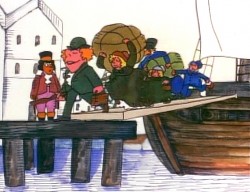
The man on the moon and the Irish immigrants.
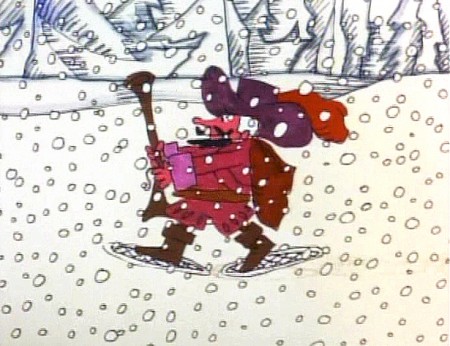
Jack Schnerk animated the French trapper sequence. There was such a rush
on the scene that I remember Jack bringing it in saying he hoped it would work.
He’d done two drawings of snow for the blizzard. Both wildly different from each other.
He asked me to ink them, then flop the drawings and ink them again.
He’d exposed the four drawings on fours. He also had the trapper with
snowshoes walking on fours. He felt it would help us feel a struggle in his
walking through the snowstorm. He felt the fours might add weight.
The scene worked beautifully, and was excellent the first time out.
Not quite the way they’d have done it at Disney. Tricks of the trade.
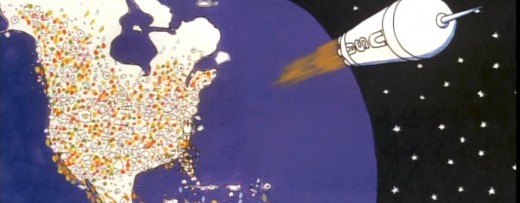
Tissa animated a majority of the film. The ending, the man going to the moon to escape
the overpopulated earth was hers. I have the drawings somewhere and will post some of them soon.
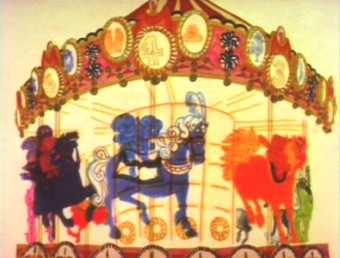 – We started slowly on Everybody Rides the Carousel. There was a six month schedule for about 72 mins of animation. Three half-hour original tv shows for CBS about 24 mins each. They’d air in the late summer of 1975 just prior to the start of the new tv season. Each show would air a day apart from the others – three nights in a row.
– We started slowly on Everybody Rides the Carousel. There was a six month schedule for about 72 mins of animation. Three half-hour original tv shows for CBS about 24 mins each. They’d air in the late summer of 1975 just prior to the start of the new tv season. Each show would air a day apart from the others – three nights in a row.
John and Faith spent a lot of time – a lot of time – at RCA studios on 45th Street. (It’s
____ The carousel was bottom lit & became soft focus.____-_ now an IRS office.) They recorded many of the voices playing the numerous parts in their show. I tried to time meeting them there a couple of times hoping to meet some of the actors (I particularly wanted to see Jack Gilford in action. He was doing an hilarious part with his wife, playing a couple of cranky old people in a diner.) It didn’t work out that way, but I did see the facility and heard parts in process.
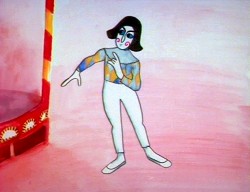 The key staff working IN the studio (not counting animators who would, for the most part, work freelance) included Ida Greenberg. Ida was a brilliant checker / coordinator who’d started back in the Florida days of the Fleischer studio. (She told me a few great stories about Gulliver’s Travels.) Ida was a great woman, with the thickest New Yowk accent, who never seemed to buckle under pressure. I grew very close to her. I tried after that to have Ida everywhere I worked. She led Raggedy Ann’s I&Pt and R.O.Blechman’s special.
The key staff working IN the studio (not counting animators who would, for the most part, work freelance) included Ida Greenberg. Ida was a brilliant checker / coordinator who’d started back in the Florida days of the Fleischer studio. (She told me a few great stories about Gulliver’s Travels.) Ida was a great woman, with the thickest New Yowk accent, who never seemed to buckle under pressure. I grew very close to her. I tried after that to have Ida everywhere I worked. She led Raggedy Ann’s I&Pt and R.O.Blechman’s special.
Kate Wodell was a student of the Hubleys at Yale. She was a talented artist who’d moved into production during the making of Cockaboody and continued on staff there. Sometimes she colored, sometimes she animated, sometimes she did whatever was necessary. This was exactly how I moved into the studio and loved the experience. She worked with Faith for many years after John died.
Earl James was an animator who’d worked in the backroom of many NY studios from Paramount to Terrytoons to NY Institute of Technology. He also had done some comic strip work.
Earl was given the carousel to animate. This came from a couple of elaborate drawings John did. Earl worked 16 fld. using a 96 drawing cycle. It gave us a lot of opportunity to move in tight or stay wide. However, it was a nightmare that took forever. Joe Gray was hired to assist Earl. (Joe started during the Terrytoons strike and never left. Many of those who knew him as a “scab” never forgave him and had only horrid things to say about him to me some thirty years later. He was a lifetime assistant like a handful of other noted names in NY.)
This scene moved so slowly through production that I kept jumping in to assist as well. I was a fast assistant, but that carousel slowed even me down. 8 horses moved in perspective in a circle; there were 96 different rotating views of all the horses. I’d guess the scene took about 10 weeks to complete.
I was also doing layout and animation of a lot of connecting scenes throughout the production. These were scenes that would have to blend from one animator to another, or John had decided to go in tight for a closeup. In one case with Art Babbitt’s mime character, I was asked to change it from two’s to four’s with a dissolve technique John taught me (he said they’d used it on Fantasia.)
There were four people in my room, Earl, Joe, me and Mark Hubley. He worked alongside me for most of the film. He colored artwork given him by Ida, who was working in the larger room next door. Mark and I had a good releationship going back the many years I worked there. He joined the studio once he completed college. Emily Hubley worked alongside Kate and Ida.
Two younger, more experimental animators were brought in by John. Adam Beckett had made a name for himself with the films he was doing at CalArts.
Fred Burns was doing some incredible work at UCLA. They both were very different and added their unique touch.

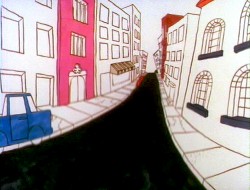
___________ Adam Beckett’s scenes included these two surreal images.
Adam did a scene a couple of scenes wherein office furniture floated about in a very complicated surreal cycle. Fred did this amazing scene of a roller coaster from the POV of the rider. He and I worked together a number of times after that, and we’ve stayed friends.
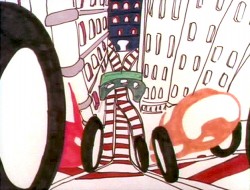
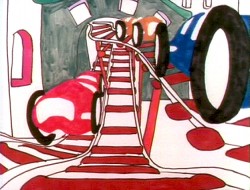
______________ Fred did this very elaborate sexual roller coaster.
I hope to have more to say about some of these films I worked on.
Articles on Animation &Hubley &repeated posts &Story & Storyboards 17 Jun 2012 05:15 am
Hub Boards – repost
Yesterday, I posted some comments about a recent piece on Signe Baumane‘s blog. This made me think about this piece I wrote back in 2007. I think it’s worth a repeat.
- The conversation on storyboard use goes way back – before the internet. If you check out the 1969 book by John Halas, Techniques of Film Animation, there’s a Q&A session wherein a number of animation greats were asked several questions, and the answers are given by question.
Here’s one question about storyboards and the answers given:
To what extent to you think a storyboard should be developed prior to production?
- GENE DEITCH: I believe in complete scene and shot breakdown in story-board or a thumbnail board form before production begins. I use a thumbnail storyboard as a sort of bar-sheet, indicating all effects, dialogue and music cues, scene transitions, etc. Great savings in cost, and an overall perspective of the film in advance are to be gained.
JOY BATCHELOR : As fully as possible without detriment to the following phases of production.
STEHPEN BOSUSTOW: If time and money allow, the storyboard should include as many details as possible, particularly if it is to be assigned to a large production unit. However, if only a few people are to be working on the picture, the storyboard can be quite sketchy, with the details being developed during production by the key people who have an overall feeling for and knowledge of the story.
ADRIAN WOOLERY: The storyboard is the first step, after the idea. Every problem must be solved and the story completely resolved on the board prior to consideration of any production.
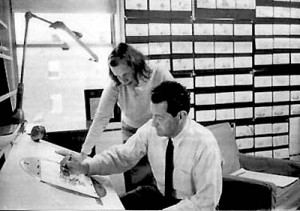 JOHN HUBLEY: It has been my experience that the more detailed a story-board and the more carefully it is designed to reflect the appearance of the finished production, the more successful the film.
JOHN HUBLEY: It has been my experience that the more detailed a story-board and the more carefully it is designed to reflect the appearance of the finished production, the more successful the film.GEOFFREY SUMNER: The storyboard, or breakdown of the film, has as many different forms as there are ways of putting actions in relation to one another.
The classic storyboard is the set of working drawings of the sequence of a film used in large studios on the Disney model where numbers of subsidiary workers must conform to a total pattern they can almost never see.
It is used in conjunction with model sheets. It could be called the “model sheet” of the sequence of the film.
It is strictly for use within a studio and should not be shown to dangerous people like sponsors.
An earlier stage is the treatment, which can be specifically directed at sponsors. If the basic idea of the film is simple, the treatment need be no more than half a dozen drawings and a brief synopsis to convey a ten minute film.
A storyboard must necessarily be constructed after the music has been done. The musician and the director can work together from a stage following the treatment. From the finished recorded track the storyboard is made.
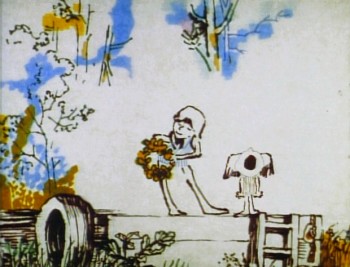 For years prior to even meeting Hubley, I had remembered his response to this question. It impressed me. His storyboard development was pretty intense. The scripts generally were done visually and tacked to the wall.
For years prior to even meeting Hubley, I had remembered his response to this question. It impressed me. His storyboard development was pretty intense. The scripts generally were done visually and tacked to the wall.
I don’t remember ever seeing text up there. John would present the board to key people, and he would give an indication of dialogue verbally. We all knew this would ultimately be ad-libbed by actors.
With the Carousel feature, sections were boarded but then developed in greater  length through improvised sessions. The boards then grew out of the edited tracks. The voices often came first, here.
length through improvised sessions. The boards then grew out of the edited tracks. The voices often came first, here.
I suspect this is probably also true of the films like Cockaboody, Windy Day and Moonbird which were dependent on the children’s verbal play at the microphone. Something like The Hole or Voyage To Next were boarded visually, then recorded improv sessions which were adapted in newer boards.
Of course it has to be remembered that the two features done within this studio, Everybody Rides The Carousel and Of Stars and Men, both started out as text. Both were heavy-duty books that were adapted for film. In the case of Of Stars and Men, the author, mathematician Harlow Shapely had major involvement in the film’s script and narrated it as well. The concepts for both films were fully worked out before anyone started boarding. So essentially a script – of sorts – existed. Since CBS financed Everybody Rides The Carousel, you know they had to approve a script.
I, of course, only remember the board.
